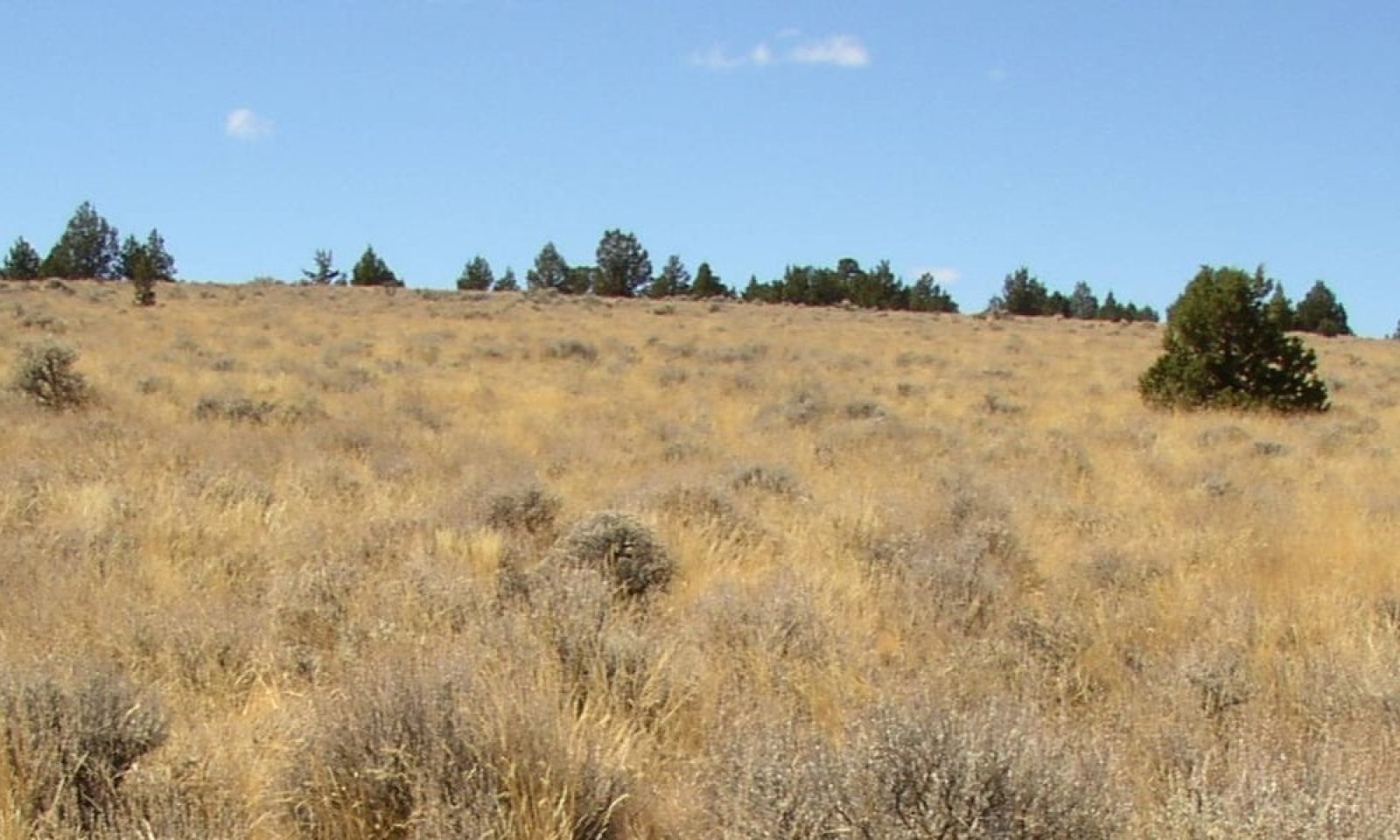

Natural Resources
Conservation Service
Ecological site R010XB029OR
JD Claypan 9-12 PZ
Last updated: 2/05/2025
Accessed: 05/10/2025
General information
Provisional. A provisional ecological site description has undergone quality control and quality assurance review. It contains a working state and transition model and enough information to identify the ecological site.
MLRA notes
Major Land Resource Area (MLRA): 010X–Central Rocky and Blue Mountain Foothills
This MLRA is characterized by gently rolling to steep hills, plateaus, and low mountains at the foothills of the Blue Mountains in Oregon and the Central Rocky Mountains in Idaho. The geology of this area is highly varied and ranges from Holocene volcanics to Cretaceous sedimentary rocks. Mollisols are the dominant soil order and the soil climate is typified by mesic or frigid soil temperature regimes, and xeric or aridic soil moisture regimes. Elevation ranges from 1,300 to 6,600 feet (395 to 2,010 meters), increasing from west to east. The climate is characterized by dry summers and snow dominated winters with precipitation averaging 8 to 16 inches (205 to 405 millimeters) and increasing from west to east. These factors support plant communities with shrub-grass associations with considerable acreage of sagebrush grassland. Big sagebrush, bluebunch wheatgrass, and Idaho fescue are the dominant species. Stiff sagebrush, low sagebrush, and Sandberg bluegrass are often dominant on sites with shallow restrictive layers. Western juniper is one of the few common tree species and since European settlement has greatly expanded its extent in Oregon. Nearly half of the MLRA is federally owned and managed by the Bureau of Land Management. Most of the area is used for livestock grazing with areas accessible by irrigation often used for irrigated agriculture.
Classification relationships
International Vegetation Classification System:
Macrogroup: M170. Great Basin-Intermountain Dwarf Sagebrush Steppe & Shrubland
Group: G308. Intermountain Low & Black Sagebrush Steppe & Shrubland
Landfire Biophysical Setting:
11240 - Columbia Plateau Low Sagebrush Steppe
Bunchgrass Plant Communities of the Blue and Ochoco Mountains:
SD1911 - Low sagebrush/Idaho fescue-bluebunch wheatgrass plant association
Ecological site concept
In reference condition, this ecological site supports a plant community dominated by little sagebrush (Artemisia arbuscula) and bluebunch wheatgrass (Pseudoroegneria spicata). Abiotically, this site is characterized claypan soils marked by a strong clay increase within 4 to 8 inches of the surface, facilitating the presence of little sagebrush. The site receives 9 to 12 inches of annual precipitation, the soil climate is Mesic near Frigid/Aridic (Xeric subclass) and resistance/resilience to disturbance is moderate to moderately low.
Associated sites
| R010XB022OR |
JD Clayey 9-12 PZ Nearby soils with a lower clay content in the argillic horizon, non-root restricting, lacking little sagebrush |
|---|---|
| R010XC021OR |
SR Clayey 9-12 PZ Adjacent areas where the depth to clay subsoil is deeper than 8 inches, lacking little sagebrush |
| R010XB023OR |
JD Shallow 9-12 PZ In complex with this site on shallow soils that have accumulated deeper ashy surfaces, lacking little sagebrush |
| R010XC035OR |
SR Shallow 9-12 PZ In complex with this site on shallow soils that have accumulated deeper ashy surfaces, lacking little sagebrush |
| R010XC038OR |
SR Very Shallow 9-12 PZ Very shallow soils, sometimes in complex with this site in geologically eroded areas, stiff sagebrush present |
Similar sites
| R010XC021OR |
SR Clayey 9-12 PZ Silty clay loam surface texture, depth to clay subsoil deeper than 8 inches, lacking little sagebrush |
|---|---|
| R010XB081OR |
JD Claypan North 12-16 PZ Higher mean annual precipitation, northerly slopes > 20% |
| R010XB096OR |
JD Claypan South 12-16 PZ Higher mean annual precipitation, southerly slopes > 12% |
| R010XB080OR |
JD Claypan 12-16 PZ Higher elevation, mean annual precipitation and production |
| R010XB082OR |
JD Shrubby Claypan 12-16 PZ Higher mean annual precipitation, overlying fractured bedrock, facilitating greater composition of bitterbrush |
Table 1. Dominant plant species
| Tree |
Not specified |
|---|---|
| Shrub |
(1) Artemisia arbuscula |
| Herbaceous |
(1) Pseudoroegneria spicata |
Physiographic features
This site occurs on terraces, hillslopes, plateaus and old alluvial fans. Slopes typically range from 2 to 20 percent. Elevations typically range from 3,600 to 4,500 feet (1,150 to 1,500 meters). This site occurs on all aspects. This site is not subject to ponding or flooding and no water table is present within the soil profile.
Table 2. Representative physiographic features
| Landforms |
(1)
Upland
> Terrace
(2) Upland > Plateau (3) Upland > Alluvial fan (4) Upland > Hillslope |
|---|---|
| Flooding frequency | None |
| Ponding frequency | None |
| Elevation | 3,600 – 4,200 ft |
| Slope | 2 – 20% |
| Aspect | Aspect is not a significant factor |
Table 3. Representative physiographic features (actual ranges)
| Flooding frequency | Not specified |
|---|---|
| Ponding frequency | Not specified |
| Elevation | 3,200 – 4,800 ft |
| Slope | 30% |
Climatic features
The annual precipitation ranges from 9 to 12 inches (225 to 300mm), most of which occurs as snow during December through February. The mean annual air temperature ranges from 43 to 49° F (6 to 9.5° C). The average frost-free period ranges from 60 to 100 days. The period of optimum plant growth is from April through June. The graphs below are populated from the closest available weather station to representative site locations and are provided to indicate general climate patterns.
Table 4. Representative climatic features
| Frost-free period (characteristic range) | 60-100 days |
|---|---|
| Freeze-free period (characteristic range) | 100-140 days |
| Precipitation total (characteristic range) | 9-12 in |
| Frost-free period (actual range) | 50-120 days |
| Freeze-free period (actual range) | 90-145 days |
| Precipitation total (actual range) | 9-14 in |
| Frost-free period (average) | 90 days |
| Freeze-free period (average) | 120 days |
| Precipitation total (average) | 11 in |
Figure 1. Monthly precipitation range
Figure 2. Monthly minimum temperature range
Figure 3. Monthly maximum temperature range
Figure 4. Monthly average minimum and maximum temperature
Figure 5. Annual precipitation pattern
Figure 6. Annual average temperature pattern
Climate stations used
-
(1) OWYHEE DAM [USC00356405], Adrian, OR
-
(2) DREWSEY [USC00352415], Drewsey, OR
Influencing water features
This site is not influenced by water from a wetland or stream.
Soil features
The soils of this site are typified by a shallow depth to claypan marked by a strong increase in clay within 4 to 8 inches of the surface. Soils may be deep overall but these heavy clay layers restrict some root penetration and cause soils to function as effectively shallow. They are formed in loess and a variety of residuum including andesite, basalt, welded tuff, diatomaceous earth and/or tuffaceous sedimentary rocks. The surface layer is typically a gravelly or cobbly loam 2 to 8 inches thick. The subsoil is typically a gravelly or cobbly clay with a clay content of 35 to 60 percent. Subsoil thickness ranges from 7 to 35 inches. Permeability is slow and the shrink-swell potential is high. The potential for water erosion is moderate. The available water holding capacity (AWC) is 2 to 4 inches. The soil temperature regime is mesic and the moisture regime is aridic (xeric subclass).
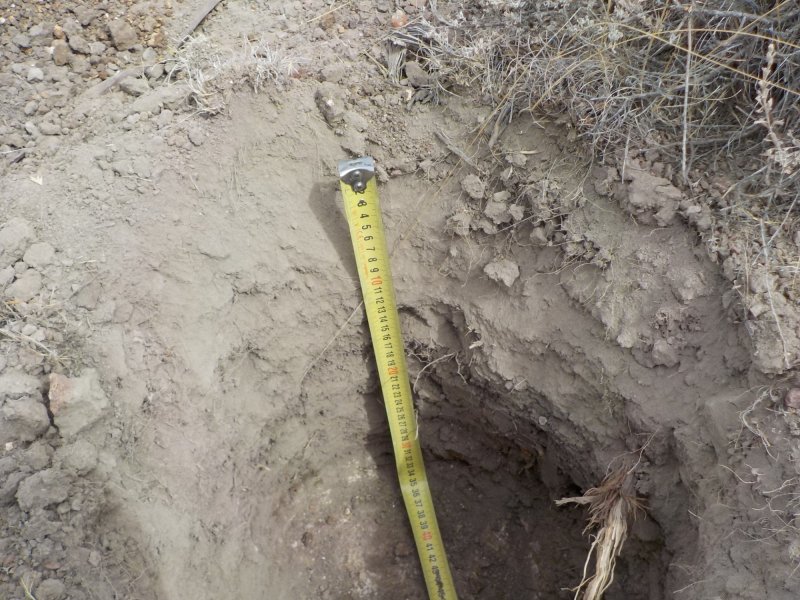
Figure 7.
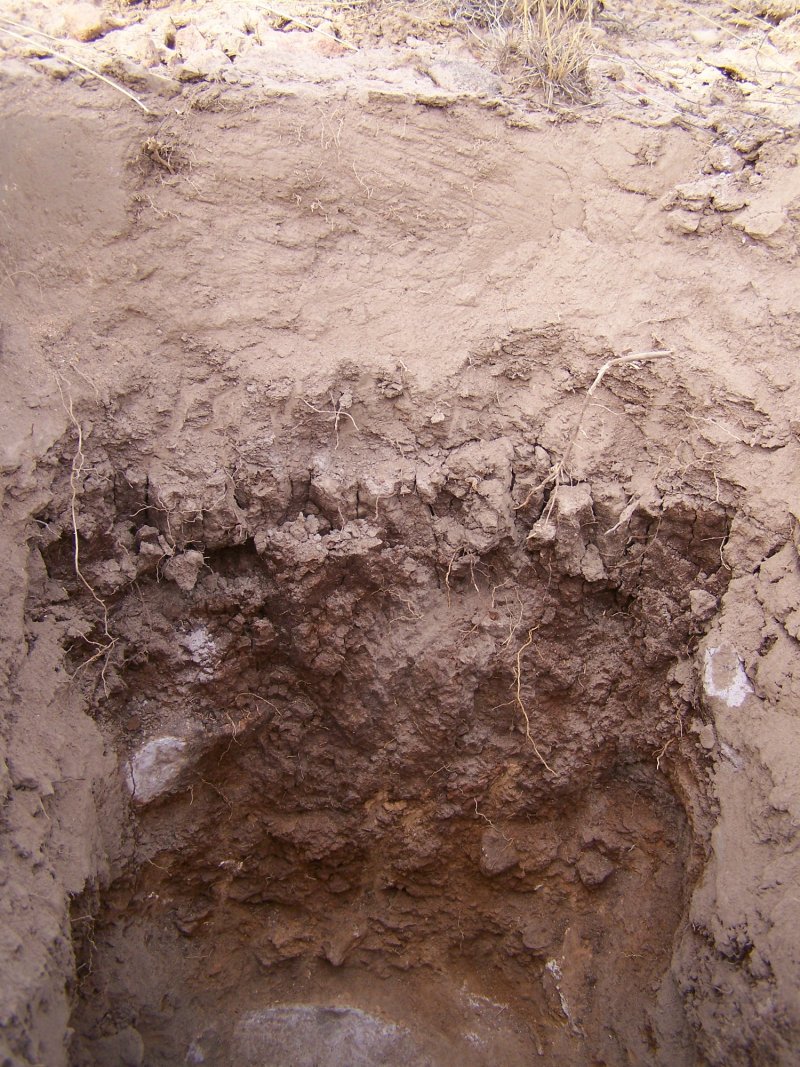
Figure 8.
Table 5. Representative soil features
| Parent material |
(1)
Residuum
–
volcanic and sedimentary rock
(2) Colluvium – volcanic and sedimentary rock (3) Alluvium (4) Volcanic ash |
|---|---|
| Surface texture |
(1) Gravelly loam (2) Ashy loam (3) Silt loam (4) Very cobbly loam |
| Family particle size |
(1) Clayey-skeletal (2) Fine (3) Clayey |
| Drainage class | Well drained |
| Permeability class | Moderately slow to moderate |
| Depth to restrictive layer | 10 – 20 in |
| Soil depth | 17 – 40 in |
| Surface fragment cover <=3" | 5 – 15% |
| Surface fragment cover >3" | 5% |
| Available water capacity (0-40in) |
2 – 3.5 in |
| Calcium carbonate equivalent (0-40in) |
Not specified |
| Clay content (0-6in) |
10 – 25% |
| Electrical conductivity (0-40in) |
Not specified |
| Sodium adsorption ratio (0-40in) |
Not specified |
| Soil reaction (1:1 water) (0-40in) |
6.6 – 7.8 |
| Subsurface fragment volume <=3" (4-40in) |
10 – 35% |
| Subsurface fragment volume >3" (4-40in) |
5 – 35% |
Table 6. Representative soil features (actual values)
| Drainage class | Well drained |
|---|---|
| Permeability class | Slow to moderately rapid |
| Depth to restrictive layer | 5 – 40 in |
| Soil depth | 15 – 50 in |
| Surface fragment cover <=3" | 2 – 30% |
| Surface fragment cover >3" | 15% |
| Available water capacity (0-40in) |
1.5 – 5 in |
| Calcium carbonate equivalent (0-40in) |
5% |
| Clay content (0-6in) |
6 – 30% |
| Electrical conductivity (0-40in) |
2 mmhos/cm |
| Sodium adsorption ratio (0-40in) |
Not specified |
| Soil reaction (1:1 water) (0-40in) |
6.6 – 8.5 |
| Subsurface fragment volume <=3" (4-40in) |
45% |
| Subsurface fragment volume >3" (4-40in) |
45% |
Ecological dynamics
Indicators and Range in Characteristics:
Little sagebrush is a strong indicator of this ecological site; given its adaptation to the unique soil conditions that define the site. This site often exists within a matrix of stiff sagebrush (Artemisia rigida) ecological sites on very shallow soil and big sagebrush (Artemesia tridentata spp.) ecological sites on deeper surface horizons. Old growth juniper may occur on this site occasionally in very low density; but tends to occur mostly toward the upper precipitation range of this site. Idaho fescue increases on soils with greater volcanic ash in the surface. Sandberg bluegrass increases on shallower soils or soils with thinner surface horizons. Broom snakeweed, (Gutierrezia sarothrae) is an additional indicator of this site relative to other claypan ecological sites.
Ecological Dynamics and Disturbance Response:
Ecological dynamics of this site are primarily driven by interactions between climatic patterns and disturbance regimes. Infrequent fires were the primary historical disturbance that maintained the reference state and drove plant community shifts within the state. Mean fire return intervals for little sagebrush communities are estimated at 100 to 200 years across their range and 97 to 183 for communities within Oregon (Landfire 2009, Bukowski and Baker 2013). Intensity and frequency of these fires is driven by relatively low fuel loads and strongly influence by drought cycles and insect or disease attacks on the plant community.
Livestock grazing is a common land use of this ecological site. Under improper grazing management, especially repeated over utilization during the growing season, cover of deep-rooted perennial grasses, such as Idaho fescue and bluebunch wheatgrass, will decrease. If improper management continues, cover of shallow-rooted perennial grasses, such as Sandberg bluegrass, and shrubs such as little sagebrush, may increase. Ongoing deterioration due to improper management will increase bare ground and release soil resources, facilitating invasion by annual grasses and forbs.
Little sagebrush has extensive fibrous roots with a greater capacity to tolerate poor aeration and extract water from lower depths than big sagebrush (Steinberg 2002); an important adaptation allowing it to thrive on seasonally saturated, claypan soils. Little sagebrush is killed by fire and will not resprout (Young 1983). Establishment after fire is from seed, which typically does not persist in the seedbank and must be dispersed from offsite (Bradley et al. 1992). After fire, if regeneration conditions are favorable, little sagebrush may recover in as little as five years, however during drought periods or on sites with low potential, recovery may require more than ten years (Young 1983). One study in Oregon found no recruitment of little sagebrush eight years post-fire (Bates and Davies 2022).
The primary perennial bunchgrass species found on this ecological site differ somewhat in their response to fire. While both Idaho fescue and bluebunch wheatgrass can survive low severity fires, Idaho fescue is characterized by somewhat higher growing points than bluebunch wheatgrass, rendering it more susceptible to damage and mortality following high severity fire (Conrad and Poulton 1966). Sandberg bluegrass (Poa secunda) is generally unharmed by fire given its low litter production and early dormancy. While increases in Sandberg bluegrass have been documented in some sagebrush systems following fire (Howard 1997), one study in a little sagebrush community found no change after eight years post-fire (Bates and Davies 2022).
Perennial forbs are an important component of the species composition of this site. Mat forming forbs such as phlox (p. hoodii and longiloba), low pussytoes (Antenaria dimorpha) and desert yellow fleabane (Erigeron linearis), are common as are geophytes such as desert parsley (Lomatium spp.) and bitter root (Lewisia rediviva); and other forbs such as lupine (Lupinus spp.) and hawksbeard (Crepis spp.). Mat forming forbs may be particularly vulnerable to decreases in cover and density following fire (Bates and Davies 2022). Interannual variation is often a significant driver of forb expression in little sagebrush communities (Bates and Davies 2022).
Relative to other claypan sites, western juniper is much less common on this ecological site, given arid conditions that restrict western juniper establishment and growth. Western juniper is intolerant of fire and historically was restricted to sites with lower fuel loads and infrequent fire regimes. Given these conditions, this site may act as refugia that allow some scattered old growth juniper to persist (Miller et al. 1999). With the increased suppression of wildfire and livestock grazing which reduces ground fuels and understory competition, western juniper has increased in range and density and expanded into suitable sites previously dominated by sagebrush (Miller and Tausch 2008, Burns and Honkala 1990). However, post settlement western juniper expansion is also likely due at least in part to changing climate and may be accelerated by increasing atmospheric CO2 levels (Miller 2019). On this site, in addition to the arid climate, high clay content in the soil subsurface slows the rate at which juniper infill and encroachment occur.
The introduced annual grass species most likely to invade these sites are cheatgrass (Bromus tectorum) and medusahead (Taeniatherum caput-medusae). North Africa grass (Ventenata dubia) is uncommon due to the warm climate that characterizes this site. All of these species compete with native herbaceous species for finite site resources and may increase fine fuel loads. Annual grass invasion, particularly cheatgrass, has been linked to increases in fire frequency in the intermountain west (Bradley et al. 2018). Medusahead invasion may promote thick, decomposition resistant thatch layers that suppress establishment of other species.
Within the natural range of variability, this site is considered to have moderate to moderately low resistance and resilience to disturbance. These attributes are driven by the warm annual temperatures and arid precipitation patterns (Mesic/Aridic(Xeric subclass) soil climate) (Chambers, et al. 2014) which make the site very susceptible to annual grass invasion. Resistance to western juniper encroachment is bolstered by the very shallow restrictive features and high clay content in the soil, in addition to a warm, dry climate, all of which interact to slow establishment of western juniper. However, in an altered state where erosion of the surface horizon occurs, this site may lose resilience more rapidly than sites supporting deeper surface horizons.
State and transition model
More interactive model formats are also available.
View Interactive Models
Click on state and transition labels to scroll to the respective text
States 2 and 5 (additional transitions)
| T1A | - | Introduction of non-native species; long-term overutilization by livestock. |
|---|---|---|
| T2A | - | Inappropriate grazing management |
| T2B | - | Time |
| T2C | - | Fire, soil disruption, inappropriate grazing management |
| T3B | - | Time |
| T3A | - | Catastrophic fire, multiple fires, and/or soil disturbing treatments, Inappropriate grazing management |
| R4A | - | Tree thinning; seeding |
| R4B | - | Mechanical tree thinning; seeding (failed) |
| T4A | - | Failed mechanical treatment, catastrophic fire |
| R5A | - | Annual grass treatment; reseeding |
State 1 submodel, plant communities
| 1.1A | - | Time and lack of disturbance |
|---|---|---|
| 1.2A | - | Fire |
State 2 submodel, plant communities
| 2.1A | - | Time, growing season grazing |
|---|---|---|
| 2.1B | - | Inappropriate grazing management |
| 2.2A | - | Fire, dormant season grazing, brush treatments, aroga moth outbreak |
| 2.2B | - | Inappropriate grazing management |
| 2.3B | - | Time, rest from grazing, reseeding, brush treatments with minimal soil disturbance |
| 2.3A | - | Time and rest from grazing, reseeding |
State 3 submodel, plant communities
| 3.1A | - | Time |
|---|---|---|
| 3.2A | - | Fire |
State 4 submodel, plant communities
| 4.1A | - | Time |
|---|
State 5 submodel, plant communities
| 5.1A | - | Fire, mechanical shrub removal |
|---|
State 1
Reference
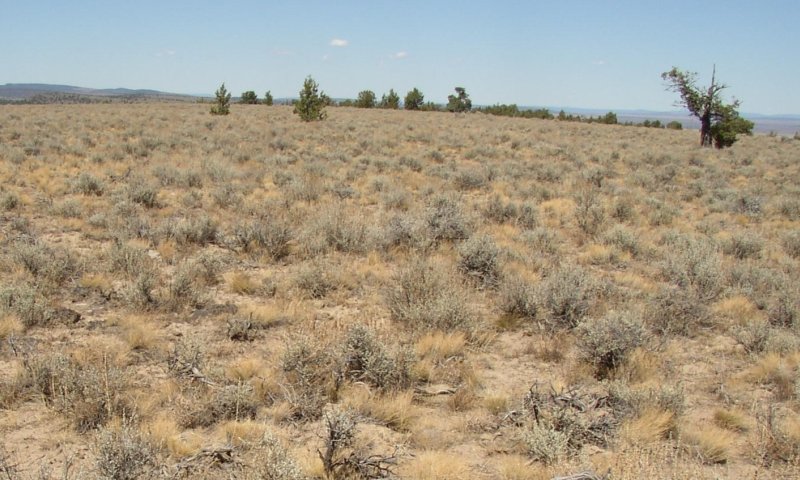
The Reference state is representative of the natural range of variability under pristine condition. While occurrence is rare, this is not considered a "Historical" reference since for this ecological site, examples of these conditions may still occur on the landscape. No introduced species occur and repeated disturbance has not fundamentally altered soil quality or plant community composition. The reference state has two general plant communities; a grass-shrub dominant community, and a shrub-grass dominant community. State dynamics are maintained by interactions between climatic patterns and disturbance regimes. Negative feedbacks enhance ecosystem resilience and contribute to the stability of the state. These include the presence of all structural and functional groups, low fine fuel loads, and retention of organic matter and nutrients. Plant community changes are primarily driven by fire, time and periodic drought.
Characteristics and indicators. • Lack of introduced plant species • Presence of all functional and structural groups • High plant vigor and reproductive capacity in most years • Lack of widespread soil erosion
Resilience management. Reference sites should be prioritized in landscape health strategies wherever possible. Management should focus on land conservation and protection of these rare conditions above other uses. Surrounding landscapes should be carefully managed to prevent species introductions and other impacts on reference sites. See the "Defend the Core" strategy for additional information (Maestas et al. 2021).
Dominant plant species
-
little sagebrush (Artemisia arbuscula), shrub
-
bluebunch wheatgrass (Pseudoroegneria spicata), grass
Community 1.1
Deep-rooted Bunchgrass and Little Sagebrush

The reference plant community is dominated by bluebunch wheatgrass with little sagebrush sub-dominant. Idaho fescue, Thurbers needlegrass, and a variety of forbs are present. Sandberg bluegrass is the dominant shallow-rooted perennial grass. Following fire, little sagebrush cover will be very patchy or absent. Vegetative composition of the community is approximately 70 percent grasses, 10 percent forbs and 20 percent shrubs. In an analysis of 56 plots collected on this ecological site between 2005 and 2020, current evidence of this community were absent; therefore, plant community data is based on previously described reference conditions.
Dominant plant species
-
little sagebrush (Artemisia arbuscula), shrub
-
bluebunch wheatgrass (Pseudoroegneria spicata), grass
Figure 9. Annual production by plant type (representative values) or group (midpoint values)
Table 7. Annual production by plant type
| Plant type | Low (lb/acre) |
Representative value (lb/acre) |
High (lb/acre) |
|---|---|---|---|
| Grass/Grasslike | 195 | 300 | 395 |
| Shrub/Vine | 30 | 50 | 80 |
| Forb | 25 | 50 | 65 |
| Tree | 0 | 0 | 10 |
| Total | 250 | 400 | 550 |
Table 8. Ground cover
| Tree foliar cover | 0-2% |
|---|---|
| Shrub/vine/liana foliar cover | 5-10% |
| Grass/grasslike foliar cover | 15-35% |
| Forb foliar cover | 5-25% |
| Non-vascular plants | 0% |
| Biological crusts | 2-5% |
| Litter | 20-35% |
| Surface fragments >0.25" and <=3" | 0-10% |
| Surface fragments >3" | 0-10% |
| Bedrock | 0.0-0.2% |
| Water | 0% |
| Bare ground | 5-20% |
Table 9. Soil surface cover
| Tree basal cover | 0.0-0.1% |
|---|---|
| Shrub/vine/liana basal cover | 0.0-0.5% |
| Grass/grasslike basal cover | 5-15% |
| Forb basal cover | 0.1-2.0% |
| Non-vascular plants | 0% |
| Biological crusts | 5-10% |
| Litter | 0.0-0.1% |
| Surface fragments >0.25" and <=3" | 1-15% |
| Surface fragments >3" | 1-15% |
| Bedrock | 0-1% |
| Water | 0% |
| Bare ground | 45-80% |
Figure 10. Plant community growth curve (percent production by month). OR4281, Claypan Warm Dry. JD Claypan South 12-16 PZ and JD Claypan 9-12 moderate to high condition..
| Jan | Feb | Mar | Apr | May | Jun | Jul | Aug | Sep | Oct | Nov | Dec |
|---|---|---|---|---|---|---|---|---|---|---|---|
| J | F | M | A | M | J | J | A | S | O | N | D |
| 0 | 0 | 10 | 20 | 30 | 20 | 5 | 0 | 10 | 5 | 0 | 0 |
Community 1.2
Little Sagebrush and Deep-rooted Bunchgrass
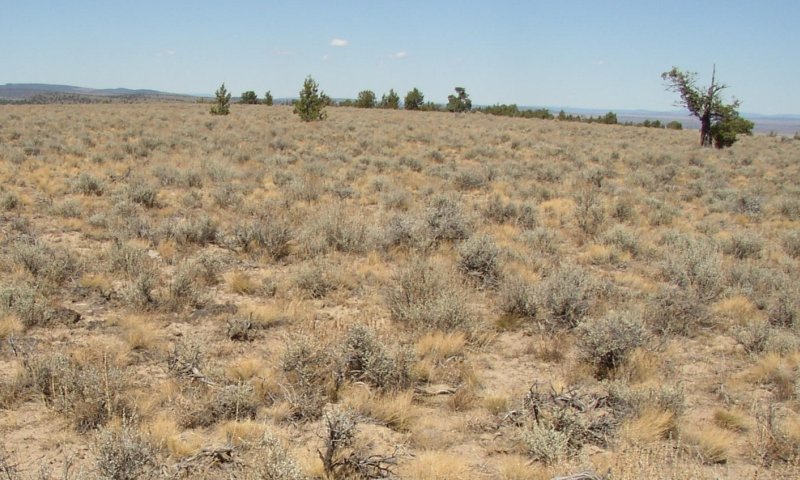
Little sagebrush is dominant and deep-rooted perennial bunchgrass, particularly bluebunch wheatgrass, are sub-dominant. A diverse forb component is typically present. Young juniper may be increasing. Annual non-native species are present but not dominant. In an analysis of 56 plots collected on this ecological site between 2005 and 2020, 2 plots (4 percent) were classified to this community.
Dominant plant species
-
little sagebrush (Artemisia arbuscula), shrub
-
bluebunch wheatgrass (Pseudoroegneria spicata), grass
Figure 11. Annual production by plant type (representative values) or group (midpoint values)
Table 10. Annual production by plant type
| Plant type | Low (lb/acre) |
Representative value (lb/acre) |
High (lb/acre) |
|---|---|---|---|
| Grass/Grasslike | 120 | 150 | 255 |
| Shrub/Vine | 110 | 200 | 240 |
| Forb | 20 | 25 | 35 |
| Tree | 0 | 0 | 20 |
| Total | 250 | 375 | 550 |
Table 11. Ground cover
| Tree foliar cover | 0-5% |
|---|---|
| Shrub/vine/liana foliar cover | 10-20% |
| Grass/grasslike foliar cover | 10-25% |
| Forb foliar cover | 2-20% |
| Non-vascular plants | 0% |
| Biological crusts | 2-5% |
| Litter | 25-40% |
| Surface fragments >0.25" and <=3" | 0-10% |
| Surface fragments >3" | 0-10% |
| Bedrock | 0.0-0.2% |
| Water | 0% |
| Bare ground | 5-20% |
Table 12. Soil surface cover
| Tree basal cover | 0.0-0.1% |
|---|---|
| Shrub/vine/liana basal cover | 0.5-1.0% |
| Grass/grasslike basal cover | 2-10% |
| Forb basal cover | 0.1-2.0% |
| Non-vascular plants | 0% |
| Biological crusts | 5-10% |
| Litter | 0.0-0.1% |
| Surface fragments >0.25" and <=3" | 2-15% |
| Surface fragments >3" | 1-15% |
| Bedrock | 0-1% |
| Water | 0% |
| Bare ground | 35-70% |
Figure 12. Plant community growth curve (percent production by month). OR4281, Claypan Warm Dry. JD Claypan South 12-16 PZ and JD Claypan 9-12 moderate to high condition..
| Jan | Feb | Mar | Apr | May | Jun | Jul | Aug | Sep | Oct | Nov | Dec |
|---|---|---|---|---|---|---|---|---|---|---|---|
| J | F | M | A | M | J | J | A | S | O | N | D |
| 0 | 0 | 10 | 20 | 30 | 20 | 5 | 0 | 10 | 5 | 0 | 0 |
Pathway 1.1A
Community 1.1 to 1.2


Time and lack of disturbance allows for shrub regeneration and growth.
Context dependence. Ungulate grazing of perennial grasses may favor increases in shrub cover
Pathway 1.2A
Community 1.2 to 1.1


Low severity fire creates a grass and sagebrush mosaic; higher severity fire significantly reduces sagebrush cover and leads to a community dominated by grasses and forbs.
Context dependence. Fire may be more likely following wet years that increase herbaceous production
State 2
Current Potential
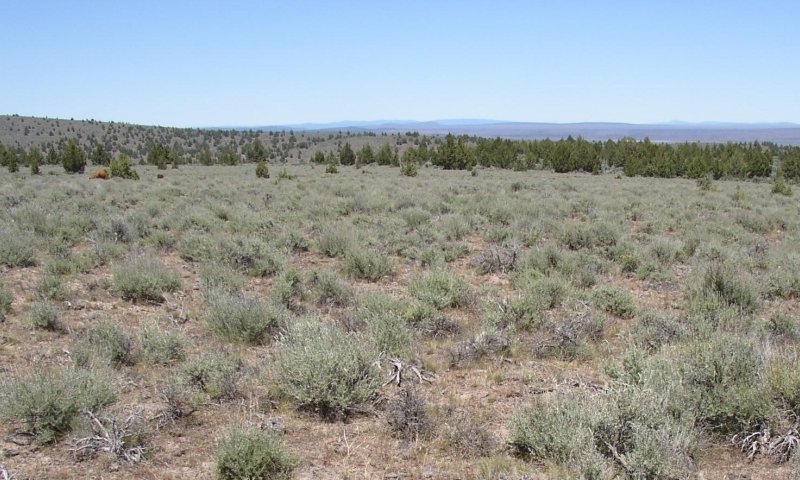
This state is similar to the reference state yet some amount of introduced species occur and species composition or soil quality has been altered by long-term overutilization by livestock. Ecological function is largely intact, however the resiliency of the state has been reduced. This state has two general communities; a grass-shrub dominant community, a shrub-grass dominant community and a shallow-rooted grass dominant community (considered an at risk-community). Introduced species may increase in abundance but will not become dominant within this State. Negative feedbacks enhance ecosystem resilience and contribute to the stability of the state. These feedbacks include the presence of all structural and functional groups, low fine fuel loads, and retention of organic matter and nutrients.
Characteristics and indicators. • Low cover of introduced plant species (less than twice as much as deep rooted perennial bunchgrass cover) • Deep rooted perennial grasses typically greater than 10 percent cover • Presence of most or all functional and structural groups • High plant vigor and reproductive capacity in most years • Lack of widespread soil erosion
Resilience management. Current potential sites in high condition should be prioritized in landscape health strategies wherever possible. Management should focus on protection, minimization of disturbance, and early detection and treatment of plant invasions. Plant community management should focus on preserving deep-rooted perennial bunchgrasses in particular. Surrounding landscapes should be carefully managed to prevent impacts to these sites. See the "Defend the Core" strategy for additional information (Maestas et al. 2021).
Dominant plant species
-
little sagebrush (Artemisia arbuscula), shrub
-
bluebunch wheatgrass (Pseudoroegneria spicata), grass
Community 2.1
Deep-rooted Bunchgrass and Little Sagebrush
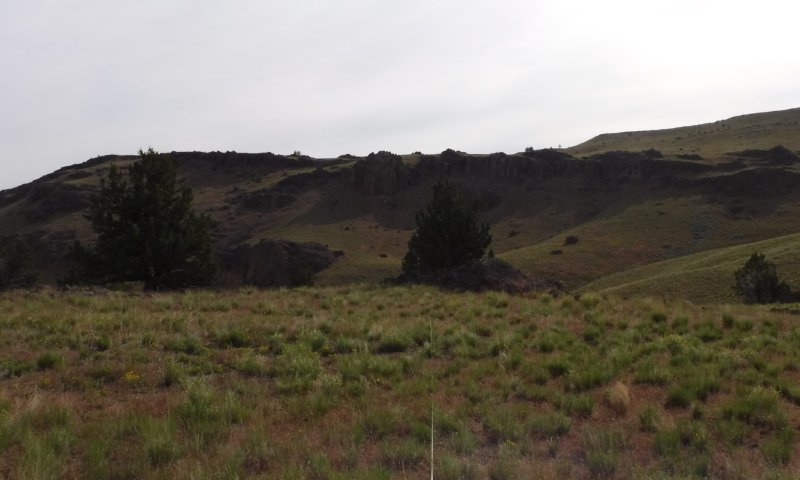
Deep-rooted perennial bunchgrasses, particularly bluebunch wheatgrass, are dominant and little sagebrush is sub-dominant and may be very patchy or even absent following fire. A diverse forb component is typically present and may be increasing. Annual non-native species are present but not dominant. In an analysis of 56 plots collected on this ecological site between 2005 and 2020, 11 plots (20 percent) were classified to this community,
Dominant plant species
-
little sagebrush (Artemisia arbuscula), shrub
-
bluebunch wheatgrass (Pseudoroegneria spicata), grass
Figure 13. Annual production by plant type (representative values) or group (midpoint values)
Table 13. Annual production by plant type
| Plant type | Low (lb/acre) |
Representative value (lb/acre) |
High (lb/acre) |
|---|---|---|---|
| Grass/Grasslike | 200 | 325 | 450 |
| Shrub/Vine | 30 | 35 | 90 |
| Forb | 20 | 40 | 65 |
| Tree | 0 | 0 | 20 |
| Total | 250 | 400 | 625 |
Table 14. Ground cover
| Tree foliar cover | 0-2% |
|---|---|
| Shrub/vine/liana foliar cover | 5-10% |
| Grass/grasslike foliar cover | 15-35% |
| Forb foliar cover | 5-25% |
| Non-vascular plants | 0% |
| Biological crusts | 0-5% |
| Litter | 10-35% |
| Surface fragments >0.25" and <=3" | 0-10% |
| Surface fragments >3" | 1-10% |
| Bedrock | 0.0-0.2% |
| Water | 0% |
| Bare ground | 5-20% |
Table 15. Soil surface cover
| Tree basal cover | 0.0-0.1% |
|---|---|
| Shrub/vine/liana basal cover | 0.0-0.5% |
| Grass/grasslike basal cover | 5-15% |
| Forb basal cover | 0.1-2.0% |
| Non-vascular plants | 0% |
| Biological crusts | 0-10% |
| Litter | 0.0-0.1% |
| Surface fragments >0.25" and <=3" | 1-15% |
| Surface fragments >3" | 2-20% |
| Bedrock | 0-1% |
| Water | 0% |
| Bare ground | 45-80% |
Figure 14. Plant community growth curve (percent production by month). OR4281, Claypan Warm Dry. JD Claypan South 12-16 PZ and JD Claypan 9-12 moderate to high condition..
| Jan | Feb | Mar | Apr | May | Jun | Jul | Aug | Sep | Oct | Nov | Dec |
|---|---|---|---|---|---|---|---|---|---|---|---|
| J | F | M | A | M | J | J | A | S | O | N | D |
| 0 | 0 | 10 | 20 | 30 | 20 | 5 | 0 | 10 | 5 | 0 | 0 |
Community 2.2
Little Sagebrush and Deep-rooted Bunchgrass
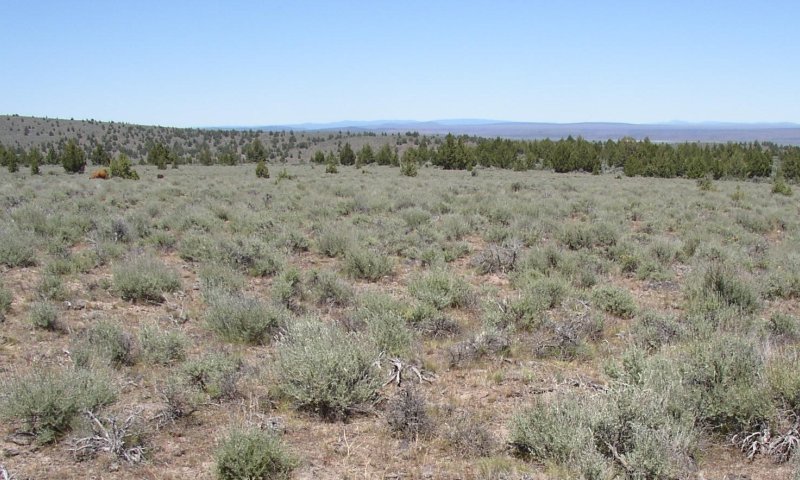
Little sagebrush is dominant and deep-rooted perennial bunchgrasses, particularly bluebunch wheatgrass, are sub-dominant. A diverse forb component is typically present. Young juniper may be increasing. Annual non-native species are present but not dominant. In an analysis of 56 plots collected on this ecological site between 2005 and 2020, 15 plots (27 percent) were classified to this community,
Dominant plant species
-
little sagebrush (Artemisia arbuscula), shrub
-
bluebunch wheatgrass (Pseudoroegneria spicata), grass
Figure 15. Annual production by plant type (representative values) or group (midpoint values)
Table 16. Annual production by plant type
| Plant type | Low (lb/acre) |
Representative value (lb/acre) |
High (lb/acre) |
|---|---|---|---|
| Grass/Grasslike | 105 | 150 | 320 |
| Shrub/Vine | 110 | 175 | 240 |
| Forb | 10 | 25 | 35 |
| Tree | 0 | 0 | 30 |
| Total | 225 | 350 | 625 |
Table 17. Ground cover
| Tree foliar cover | 0-5% |
|---|---|
| Shrub/vine/liana foliar cover | 10-20% |
| Grass/grasslike foliar cover | 10-25% |
| Forb foliar cover | 2-20% |
| Non-vascular plants | 0% |
| Biological crusts | 1-5% |
| Litter | 20-40% |
| Surface fragments >0.25" and <=3" | 1-15% |
| Surface fragments >3" | 2-15% |
| Bedrock | 0.0-0.2% |
| Water | 0% |
| Bare ground | 5-20% |
Table 18. Soil surface cover
| Tree basal cover | 0.0-0.1% |
|---|---|
| Shrub/vine/liana basal cover | 0.5-1.0% |
| Grass/grasslike basal cover | 2-10% |
| Forb basal cover | 0.1-2.0% |
| Non-vascular plants | 0% |
| Biological crusts | 2-10% |
| Litter | 0.0-0.1% |
| Surface fragments >0.25" and <=3" | 2-15% |
| Surface fragments >3" | 1-20% |
| Bedrock | 0-1% |
| Water | 0% |
| Bare ground | 35-70% |
Figure 16. Plant community growth curve (percent production by month). OR4281, Claypan Warm Dry. JD Claypan South 12-16 PZ and JD Claypan 9-12 moderate to high condition..
| Jan | Feb | Mar | Apr | May | Jun | Jul | Aug | Sep | Oct | Nov | Dec |
|---|---|---|---|---|---|---|---|---|---|---|---|
| J | F | M | A | M | J | J | A | S | O | N | D |
| 0 | 0 | 10 | 20 | 30 | 20 | 5 | 0 | 10 | 5 | 0 | 0 |
Community 2.3
Shallow-rooted Bunchgrass and Little Sagebrush
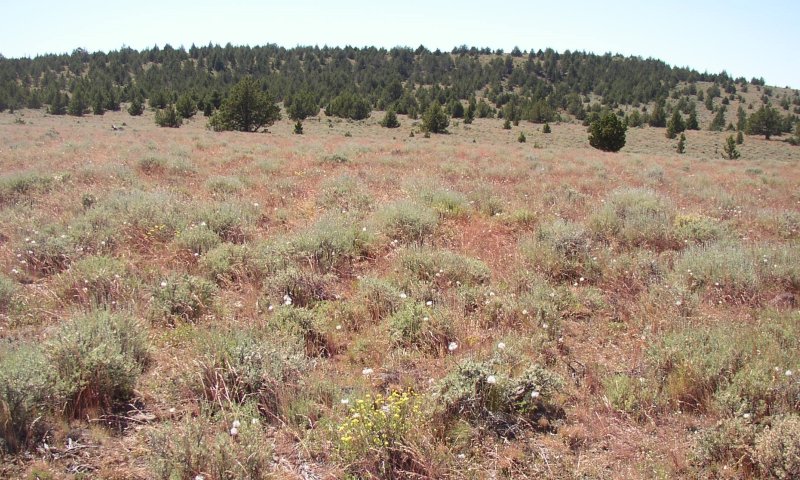
Shallow-rooted perennial bunchgrass, particularly Sandberg bluegrass, is dominant and little sagebrush is codominant. Deep-rooted perennial bunchgrass are sub-dominant but still typically occupy at least 10% cover. Some of the soil surface may have been degraded due to compaction or minor erosion. Young juniper may be increasing. Introduced annual species present to increasing. This is considered an at-risk phase due to the loss of some of the deep-rooted bunchgrass component and typically an increase in introduced annual species, bare ground, and gap cover. In an analysis of 56 plots collected on this ecological site between 2005 and 2020, nine plots (16 percent) were classified to this community,
Dominant plant species
-
little sagebrush (Artemisia arbuscula), shrub
-
Sandberg bluegrass (Poa secunda), grass
Figure 17. Annual production by plant type (representative values) or group (midpoint values)
Table 19. Annual production by plant type
| Plant type | Low (lb/acre) |
Representative value (lb/acre) |
High (lb/acre) |
|---|---|---|---|
| Grass/Grasslike | 90 | 150 | 265 |
| Shrub/Vine | 60 | 100 | 185 |
| Forb | 25 | 50 | 80 |
| Tree | 0 | 0 | 20 |
| Total | 175 | 300 | 550 |
Table 20. Ground cover
| Tree foliar cover | 0-5% |
|---|---|
| Shrub/vine/liana foliar cover | 10-20% |
| Grass/grasslike foliar cover | 20-30% |
| Forb foliar cover | 5-30% |
| Non-vascular plants | 0% |
| Biological crusts | 1-7% |
| Litter | 10-40% |
| Surface fragments >0.25" and <=3" | 1-20% |
| Surface fragments >3" | 2-15% |
| Bedrock | 0.0-0.2% |
| Water | 0% |
| Bare ground | 10-25% |
Table 21. Soil surface cover
| Tree basal cover | 0.0-0.1% |
|---|---|
| Shrub/vine/liana basal cover | 0.5-1.0% |
| Grass/grasslike basal cover | 2-10% |
| Forb basal cover | 0.5-3.0% |
| Non-vascular plants | 0% |
| Biological crusts | 2-10% |
| Litter | 0.0-0.1% |
| Surface fragments >0.25" and <=3" | 10-40% |
| Surface fragments >3" | 1-25% |
| Bedrock | 0-1% |
| Water | 0% |
| Bare ground | 25-75% |
Figure 18. Plant community growth curve (percent production by month). OR4282, Claypan Warm Dry, poor condition. JD Claypan South 12-16 PZ and JD Claypan 9-12 poor condition. This curve is extrapolated from the OR4281 curve..
| Jan | Feb | Mar | Apr | May | Jun | Jul | Aug | Sep | Oct | Nov | Dec |
|---|---|---|---|---|---|---|---|---|---|---|---|
| J | F | M | A | M | J | J | A | S | O | N | D |
| 0 | 0 | 10 | 25 | 30 | 15 | 5 | 0 | 10 | 5 | 0 | 0 |
Pathway 2.1A
Community 2.1 to 2.2


Time and lack of disturbance allows for shrub growth and regeneration.
Context dependence. Ungulate grazing during the growing season may also reduce deep-rooted perennial bunchgrass composition relative to little sagebrush.
Pathway 2.1B
Community 2.1 to 2.3


Inappropriate grazing management, or excessive wildlife grazing, especially during the growing season may reduce deep-rooted perennial bunchgrasses. Soil compaction as a result of inappropriate grazing management may also favor shallow-rooted bunchgrass dominance.
Context dependence. Drought may accelerate or exacerbate change; soils are particularly susceptible to compaction when moist.
Pathway 2.2A
Community 2.2 to 2.1


Low severity fire creates a grass and shrub mosaic; higher severity fire significantly reduces sagebrush cover and leads to community dominated by grasses and forbs. Aroga moth outbreaks may decrease little sagebrush. Brush treatments with minimal soil disturbance may reduce the shrub overstory. Dormant season grazing by ungulates, particularly sheep, may also decrease little sagebrush composition.
Context dependence. Soil disturbance will be influenced by season of treatment or grazing
Pathway 2.2B
Community 2.2 to 2.3


Inappropriate year-round grazing may reduce deep-rooted bunchgrasses and little sagebrush relative to Sandberg bluegrass. Brush treatments that lead to soil compaction may reduce shrubs and deep-rooted bunchgrasses. Soil compaction as a result of inappropriate grazing management may also favor shallow-rooted bunchgrass dominance.
Context dependence. Drought may accelerate or exacerbate change; soils are particularly susceptible to compaction when moist.
Pathway 2.3B
Community 2.3 to 2.1


Time and rest from growing season grazing may promote an increase in deep-rooted perennial bunchgrasses. Brush treatments with minimal soil disturbance may reduce the shrub overstory. Dormant season grazing by ungulates, particularly sheep, may also decrease little sagebrush composition.
Context dependence. Above average growing season precipitation may increase establishment success; if deep-rooted bunchgrass establishment is limited by reproductive vigor, reseeding may be required
Pathway 2.3A
Community 2.3 to 2.2


Time and rest from excessive grazing allows the shrub overstory to mature. Deep-rooted bunchgrasses may increase in the absence of disturbance if conditions are favorable.
Context dependence. If deep-rooted bunchgrass establishment is limited by reproductive vigor, reseeding may be required
State 3
Degraded
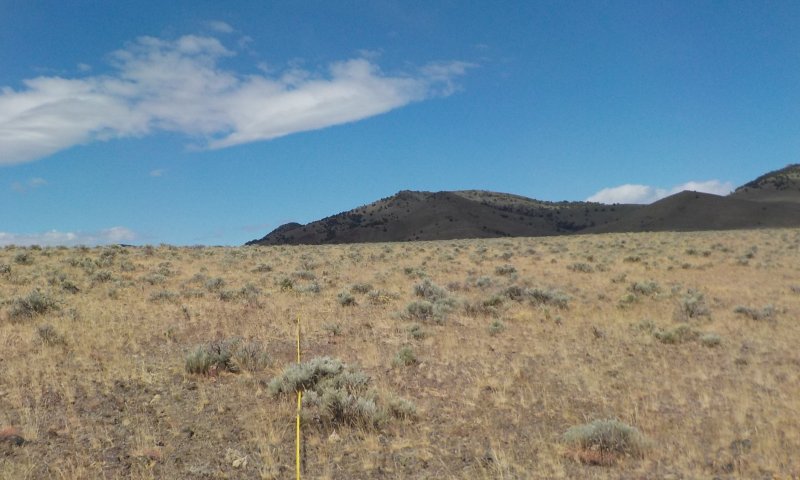
This state is a product of many years of heavy grazing during growth periods of cool season, perennial bunchgrasses. Much of the deep-rooted perennial bunchgrass component has been lost and cover rarely exceeds 5 to 7 percent. Erosion of part of the surface soil horizon may have occurred and may be ongoing. Sandberg bluegrass will increase with a reduction in deep-rooted perennial bunchgrass competition and become the dominant grass. This state consists of two plant communities, a shallow-rooted bunchgrass dominant community and a little sagebrush, shallow-rooted bunchgrass community. Introduced species cover is typically higher than in the current potential state. The shrub overstory and bluegrass understory dominate site resources such that soil water, nutrient capture, nutrient cycling and soil organic matter are temporally and spatially redistributed.
Characteristics and indicators. • Low cover and production of deep-rooted perennial bunchgrasses (typically less than 7 percent cover) • Moderate to high cover of shallow-rooted perennial bunchgrasses • Variable cover of little sagebrush • Evidence of soil erosion
Resilience management. Management should focus on preserving and reintroducing deep-rooted perennial bunchgrasses and treating introduced annual species to prevent a transition to an annual state.
Dominant plant species
-
little sagebrush (Artemisia arbuscula), shrub
-
Sandberg bluegrass (Poa secunda), grass
Community 3.1
Shallow-rooted Bunchgrass
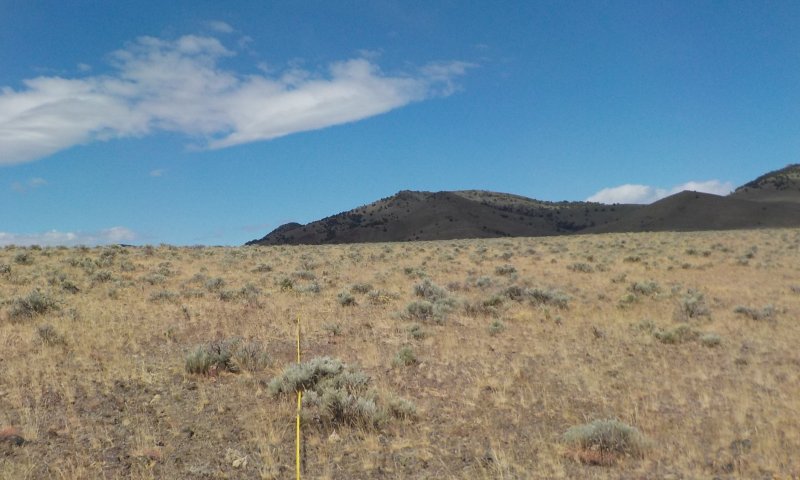
Sandberg bluegrass is dominant and little sagebrush decreased. Deep-rooted perennial grasses are a minor component or missing. Non-native annual species present to increasing. Western juniper present to increasing. In an analysis of 56 plots collected on this ecological site between 2005 and 2020, six plots (11 percent) were classified to this community, none of these plots included production estimates, so production values are limited to functional group values extrapolated from similar communities.
Dominant plant species
-
Sandberg bluegrass (Poa secunda), grass
Figure 19. Annual production by plant type (representative values) or group (midpoint values)
Table 22. Annual production by plant type
| Plant type | Low (lb/acre) |
Representative value (lb/acre) |
High (lb/acre) |
|---|---|---|---|
| Grass/Grasslike | 130 | 160 | 165 |
| Forb | 10 | 45 | 80 |
| Shrub/Vine | 10 | 30 | 50 |
| Tree | 0 | 15 | 30 |
| Total | 150 | 250 | 325 |
Figure 20. Plant community growth curve (percent production by month). OR4282, Claypan Warm Dry, poor condition. JD Claypan South 12-16 PZ and JD Claypan 9-12 poor condition. This curve is extrapolated from the OR4281 curve..
| Jan | Feb | Mar | Apr | May | Jun | Jul | Aug | Sep | Oct | Nov | Dec |
|---|---|---|---|---|---|---|---|---|---|---|---|
| J | F | M | A | M | J | J | A | S | O | N | D |
| 0 | 0 | 10 | 25 | 30 | 15 | 5 | 0 | 10 | 5 | 0 | 0 |
Community 3.2
Little Sagebrush, Shallow-rooted Bunchgrass and Annuals
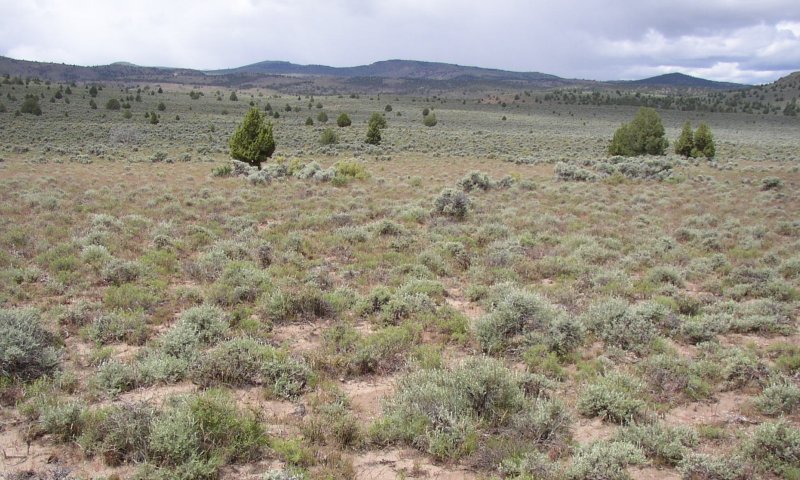
Little sagebrush is dominant. Sandberg bluegrass increases. Deep-rooted perennial grasses are a minor component or missing. Non-native annual species present to increasing. Western juniper present to increasing. In an analysis of 56 plots collected on this ecological site between 2005 and 2020, two plots (4 percent) were classified to this community.
Dominant plant species
-
little sagebrush (Artemisia arbuscula), shrub
-
Sandberg bluegrass (Poa secunda), grass
Figure 21. Annual production by plant type (representative values) or group (midpoint values)
Table 23. Annual production by plant type
| Plant type | Low (lb/acre) |
Representative value (lb/acre) |
High (lb/acre) |
|---|---|---|---|
| Shrub/Vine | 140 | 200 | 250 |
| Grass/Grasslike | 50 | 100 | 190 |
| Forb | 10 | 20 | 30 |
| Tree | 0 | 5 | 30 |
| Total | 200 | 325 | 500 |
Figure 22. Plant community growth curve (percent production by month). OR4282, Claypan Warm Dry, poor condition. JD Claypan South 12-16 PZ and JD Claypan 9-12 poor condition. This curve is extrapolated from the OR4281 curve..
| Jan | Feb | Mar | Apr | May | Jun | Jul | Aug | Sep | Oct | Nov | Dec |
|---|---|---|---|---|---|---|---|---|---|---|---|
| J | F | M | A | M | J | J | A | S | O | N | D |
| 0 | 0 | 10 | 25 | 30 | 15 | 5 | 0 | 10 | 5 | 0 | 0 |
Pathway 3.1A
Community 3.1 to 3.2


Time without disturbance
Context dependence. Shrub regeneration and growth may depend on nearby availability of seed source and/or shrub reproductive vigor
Pathway 3.2A
Community 3.2 to 3.1


Fire reduces shrub component
Context dependence. Years of above average precipitation may increase herbaceous fuels and increase the probability of fire
State 4
Encroached
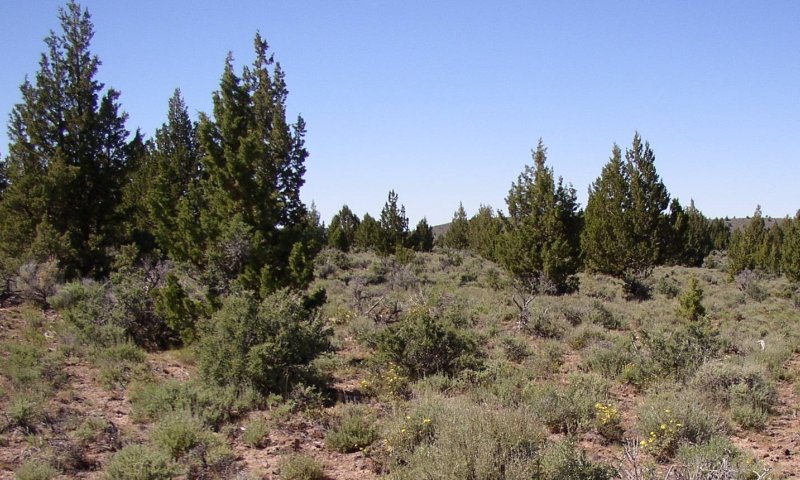
In this state the site has crossed a threshold and is dominated by western juniper. Low sagebrush and perennial bunchgrasses may still be present, but they are no longer controlling site resources. As juniper cover increases, shrub cover typically decreases, therefore this site is characterized by two communities, a western juniper/shrub community and a western juniper dominated community. Soil moisture, soil nutrients and soil organic matter distribution and cycling have been spatially and temporally altered. Soil erosion may accelerate as perennial herbaceous cover decreases. Relative to other claypan sites, western juniper is much less common on this ecological site, and a transition to this state is less probable and will occur more slowly given arid conditions that restrict western juniper establishment and growth.
Characteristics and indicators. • Western juniper canopy cover 10 to 25 percent (or greater) (see Miller et al. 2007 for additional context) • Deep-rooted perennial bunchgrasses and little sagebrush decreased • Evidence of soil erosion common
Resilience management. Management should focus on preserving and reintroducing deep-rooted perennial bunchgrasses and treating western juniper to prevent further loss of other plant functional groups. Communities at earlier stages of invasion will have the highest likelihood of restoration success (See Miller et al. 2007). Special care should be taken to avoid removal of old growth western juniper.
Dominant plant species
-
western juniper (Juniperus occidentalis), tree
-
little sagebrush (Artemisia arbuscula), shrub
-
Sandberg bluegrass (Poa secunda), grass
Community 4.1
Western Juniper and Little Sagebrush
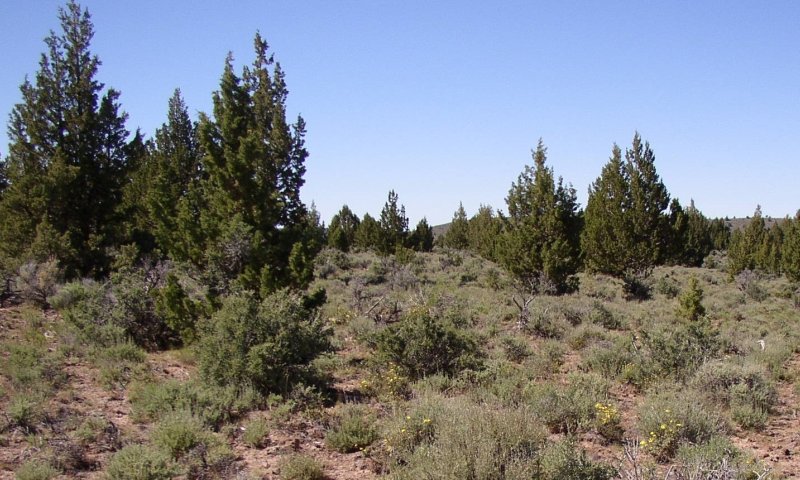
Western juniper is co-dominant relative to sagebrush and deep-rooted perennial grasses. Sandberg bluegrass may be increasing in the understory. Non-native annual species are often common. The site will be expressing stage 1 or early stage 2 juniper invasion (see Miller et al. USGS, 2007). In an analysis of 56 plots collected on this ecological site between 2005 and 2020, two plots (4 percent) were classified to this community.
Dominant plant species
-
western juniper (Juniperus occidentalis), tree
-
little sagebrush (Artemisia arbuscula), shrub
-
Sandberg bluegrass (Poa secunda), grass
Community 4.2
Western Juniper
Western juniper dominates and shrub cover is diminished. For this site this transition typically occurs at a 20 percent or greater canopy cover of juniper where the site will be expressing late stage 2 or stage 3 juniper invasion (see Miller et al. USGS, 2007). Sandberg bluegrass may be dominant in the understory and non-native annual species may be abundant. As juniper cover increases, shrubs are eliminated, infiltration decreases, soil moisture is reduced and erosion accelerates. Idaho fescue typically persists longer than other deep-rooted bunchgrasses due to its shade tolerance. It may be very challenging to restore ecological function once the site has reached this community. In an analysis of 56 plots collected on this ecological site between 2005 and 2020, two plots (4 percent) were classified to this community.
Dominant plant species
-
western juniper (Juniperus occidentalis), tree
-
Sandberg bluegrass (Poa secunda), grass
Pathway 4.1A
Community 4.1 to 4.2
Time without fire allows cover to increase.
Context dependence. Above average precipitation may facilitate wester juniper regeneration and growth (Miller 2019).
State 5
Annual

In this state, the site has crossed a threshold into a state dominated by introduced annual species, especially invasive annual grasses. Invasive annual grasses become increasingly dominant though time by altering nutrient cycling, litter creation, and soil moisture capture thereby promoting positive feedbacks. An increase in fire frequency may also occur due to higher fine fuel loads that become flammable earlier in the season. Shrub and tree cover is variable. Shallow-rooted perennial grasses are common but are no longer controlling site resources.
Characteristics and indicators. • Annual grass cover typically greater than 25% • Deep-rooted perennial grass cover typically less than 5% • Annual grass cover greater than twice as much as deep-rooted perennial grass cover • Little sagebrush cover may be very low • Herbaceous litter cover may be abnormally high, especially in summer
Resilience management. Focus management actions on reducing invasive annual grass cover and spread to adjacent sites.
Dominant plant species
-
little sagebrush (Artemisia arbuscula), shrub
-
cheatgrass (Bromus tectorum), grass
-
medusahead (Taeniatherum caput-medusae), grass
-
North Africa grass (Ventenata dubia), grass
Community 5.1
Annual Grass and Shrubs
Introduced annual grasses are dominant and shrubs are sub-dominant. Annual native and introduced forbs may also be common. The little sagebrush component of the site is typically still intact but may be replaced by resprouting rabbitbrush species if fire occurs.
Dominant plant species
-
medusahead (Taeniatherum caput-medusae), grass
-
cheatgrass (Bromus tectorum), grass
Community 5.2
Annual Grass
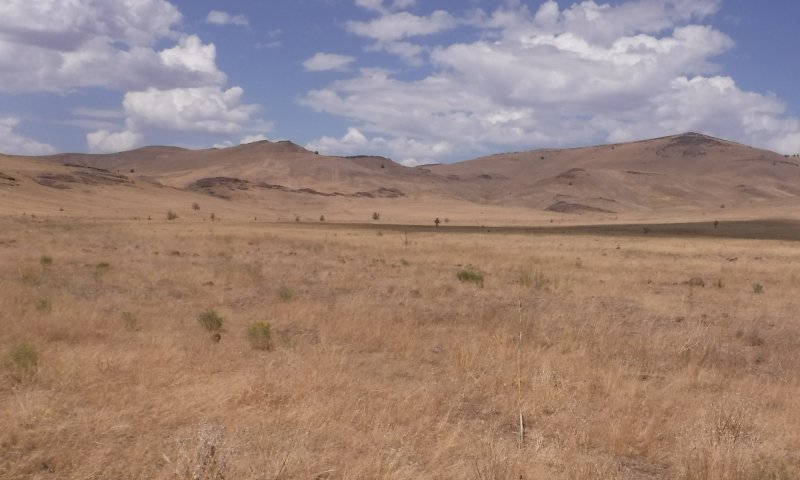
Introduced annual grasses are dominant. Annual native and introduced forbs may also be common. Dominant annual grasses include medusahead and cheatgrass. Cover of little sagebrush and western juniper is variable but will decrease, and likely remain suppressed, if fire occurs. In an analysis of 56 plots collected on this ecological site between 2005 and 2020, six plots (11%) were classified to this community, none of which included production data.
Dominant plant species
-
cheatgrass (Bromus tectorum), grass
-
medusahead (Taeniatherum caput-medusae), grass
Figure 23. Annual production by plant type (representative values) or group (midpoint values)
Table 24. Ground cover
| Tree foliar cover | 0-1% |
|---|---|
| Shrub/vine/liana foliar cover | 0-2% |
| Grass/grasslike foliar cover | 40-80% |
| Forb foliar cover | 2-15% |
| Non-vascular plants | 0% |
| Biological crusts | 0-1% |
| Litter | 1-25% |
| Surface fragments >0.25" and <=3" | 0-15% |
| Surface fragments >3" | 1-15% |
| Bedrock | 0.0-0.2% |
| Water | 0% |
| Bare ground | 5-20% |
Table 25. Soil surface cover
| Tree basal cover | 0.0-0.1% |
|---|---|
| Shrub/vine/liana basal cover | 0.0-0.5% |
| Grass/grasslike basal cover | 2-20% |
| Forb basal cover | 0-1% |
| Non-vascular plants | 0% |
| Biological crusts | 0-2% |
| Litter | 0.0-0.1% |
| Surface fragments >0.25" and <=3" | 1-20% |
| Surface fragments >3" | 2-20% |
| Bedrock | 0-1% |
| Water | 0% |
| Bare ground | 55-80% |
Figure 24. Plant community growth curve (percent production by month). OR4283, Claypan Warm Dry, annual invaded. JD Claypan South 12-16 PZ and JD Claypan 9-12 annual invaded. This curve is extrapolated from the OR4281 curve..
| Jan | Feb | Mar | Apr | May | Jun | Jul | Aug | Sep | Oct | Nov | Dec |
|---|---|---|---|---|---|---|---|---|---|---|---|
| J | F | M | A | M | J | J | A | S | O | N | D |
| 0 | 0 | 15 | 25 | 25 | 15 | 5 | 0 | 10 | 5 | 0 | 0 |
Pathway 5.1A
Community 5.1 to 5.2
Fire occurs and eliminates shrubs. May also be caused by a mechanical shrub removal treatment.
Context dependence. Probability of fire may increase following successive years with increased spring precipitation and high annual grass production
Transition T1A
State 1 to 2


Introduction of non-native species; long-term overutilization by livestock.
Context dependence. Ecological drought may increase the likelihood of this transition
Transition T2A
State 2 to 3


Inappropriate grazing management, especially repeated growing season over utilization, will reduce deep-rooted perennial grasses and lead to soil compaction and eventually erosion
Context dependence. Soil is particularly vulnerable to compaction during late winter and spring when it is moist or saturated but unfrozen; this transition is most likely to occur from the 2.3 at-risk phase.
Transition T2B
State 2 to 4


Time and lack of fire allows for maturation of the tree community
Context dependence. Years with above average precipitation may accelerate establishment and growth of western juniper (Miller et al. 2019); adjacent seed sources will also increase juniper establishment rates.
Transition T2C
State 2 to 5


Catastrophic fire, multiple fires, soil disturbing treatments, inappropriate grazing management
Context dependence. Transition rate and probability will depend on existing cover, reproductive vigor and seedbank density of invasive annual species; higher than normal spring precipitation may interact with these disturbances to further favor increases in annual plant composition; this transition may be more likely to occur from the 2.3 at-risk phase.
Transition T3B
State 3 to 4


Time and lack of fire allows for maturation of the tree community
Context dependence. Years with above average precipitation may accelerate establishment and growth of western juniper (Miller et al. 2019); adjacent seed sources will also increase juniper establishment rates.
Transition T3A
State 3 to 5


Catastrophic fire, multiple fires, soil disturbing treatments, inappropriate grazing management
Context dependence. Transition rate and probability will depend on existing cover, reproductive vigor and seedbank density of invasive annual species; higher than normal spring precipitation may interact with these disturbances to further favor increases in annual plant composition
Restoration pathway R4A
State 4 to 2


Thinning of trees, potentially coupled with seeding of desired species if required. Use of fire should be restricted to sites without little sagebrush and very low cover of annual species.
Context dependence. If most functional groups are still present, community 4.1 may be potentially restored to State 2; if most functional groups have been diminished or soil loss has occurred, 4.2 is likely to restore to State 3. Hand thinning may help decrease soil disruption while mechanical thinning may increase compaction; seeding success is low on this site and will depend in part on existing exotic grass pressure.
Restoration pathway R4B
State 4 to 3


Ground disturbing mechanical tree thinning treatment; potentially coupled with a failed seeding. Use of fire should be restricted to sites without little sagebrush and very low cover of annual species.
Context dependence. If most functional groups are still present, community 4.1 may be potentially restored to State 2; if most functional groups have been diminished or soil loss has occurred, 4.2 is likely to restore to State 3. Hand thinning may help decrease soil disruption while mechanical thinning may compact soils and increase the likelihood of a transition to State 3; seeding success is low on this site and will depend in part on existing exotic grass pressure.
Transition T4A
State 4 to 5


Ground disturbing mechanical treatment, catastrophic fire
Context dependence. Transition rate and probability will depend on existing cover, reproductive vigor and seedbank density of invasive annual species
Restoration pathway R5A
State 5 to 3


Treatment of annual grasses, likely requiring herbicide application; coupled with seeding of desired native species
Context dependence. Above average growing season precipitation may increase establishment success; restoration success will be much more likely from community 5.1 than 5.2 given a greater composition of functional groups
Additional community tables
Table 26. Community 1.1 plant community composition
| Group | Common name | Symbol | Scientific name | Annual production (lb/acre) | Foliar cover (%) | |
|---|---|---|---|---|---|---|
|
Grass/Grasslike
|
||||||
| 1 | Deep Rooted Perennial Grasses, Dominant | 175–305 | ||||
| bluebunch wheatgrass | PSSP6 | Pseudoroegneria spicata | 155–200 | – | ||
| Idaho fescue | FEID | Festuca idahoensis | 0–90 | – | ||
| prairie Junegrass | KOMA | Koeleria macrantha | 20–40 | – | ||
| 2 | Other Deep Rooted Perennial Grasses | 0–30 | ||||
| Thurber's needlegrass | ACTH7 | Achnatherum thurberianum | 0–15 | – | ||
| squirreltail | ELEL5 | Elymus elymoides | 0–15 | – | ||
| 3 | Shallow Rooted Perennial Grasses | 20–60 | ||||
| Sandberg bluegrass | POSE | Poa secunda | 20–60 | – | ||
|
Forb
|
||||||
| 4 | Perennial Forbs | 25–65 | ||||
| buckwheat | ERIOG | Eriogonum | 0–12 | – | ||
| phlox | PHLOX | Phlox | 0–12 | – | ||
| balsamroot | BALSA | Balsamorhiza | 0–12 | – | ||
| largehead clover | TRMA3 | Trifolium macrocephalum | 0–12 | – | ||
| erigenia | ERIGE | Erigenia | 0–12 | – | ||
| desertparsley | LOMAT | Lomatium | 0–12 | – | ||
| common yarrow | ACMI2 | Achillea millefolium | 0–12 | – | ||
| pussytoes | ANTEN | Antennaria | 0–12 | – | ||
|
Shrub/Vine
|
||||||
| 10 | Shrubs, Dominant | 30–60 | ||||
| little sagebrush | ARAR8 | Artemisia arbuscula | 30–60 | – | ||
| 11 | Other Perennial Shrubs | 0–20 | ||||
| Truckee rabbitbrush | CHHU2 | Chrysothamnus humilis | 0–10 | – | ||
| yellow rabbitbrush | CHVI8 | Chrysothamnus viscidiflorus | 0–10 | – | ||
| antelope bitterbrush | PUTR2 | Purshia tridentata | 0–10 | – | ||
| Wyoming big sagebrush | ARTRW8 | Artemisia tridentata ssp. wyomingensis | 0–10 | – | ||
|
Tree
|
||||||
| 12 | Tree, Evergreen | 0–10 | ||||
| western juniper | JUOC | Juniperus occidentalis | 0–10 | – | ||
Table 27. Community 1.2 plant community composition
| Group | Common name | Symbol | Scientific name | Annual production (lb/acre) | Foliar cover (%) | |
|---|---|---|---|---|---|---|
|
Grass/Grasslike
|
||||||
| 1 | Perennial, deep-rooted, dominant | 100–150 | ||||
| bluebunch wheatgrass | PSSP6 | Pseudoroegneria spicata | 100–175 | – | ||
| Idaho fescue | FEID | Festuca idahoensis | 0–80 | – | ||
| 2 | Perennial, deep-rooted | 10–30 | ||||
| Thurber's needlegrass | ACTH7 | Achnatherum thurberianum | 5–20 | – | ||
| squirreltail | ELEL5 | Elymus elymoides | 0–10 | – | ||
| prairie Junegrass | KOMA | Koeleria macrantha | 0–10 | – | ||
| 3 | Perennial, shallow-rooted, sub-dominant | 10–50 | ||||
| Sandberg bluegrass | POSE | Poa secunda | 10–50 | – | ||
|
Forb
|
||||||
| 4 | Perennial forbs | 15–25 | ||||
| lupine | LUPIN | Lupinus | 0–10 | – | ||
| buckwheat | ERIOG | Eriogonum | 0–10 | – | ||
| fleabane | ERIGE2 | Erigeron | 0–5 | – | ||
| spiny phlox | PHHO | Phlox hoodii | 0–5 | – | ||
| pussytoes | ANTEN | Antennaria | 0–5 | – | ||
| milkvetch | ASTRA | Astragalus | 0–5 | – | ||
| longleaf phlox | PHLO2 | Phlox longifolia | 0–5 | – | ||
| 6 | Annual forbs, native | 5–10 | ||||
| maiden blue eyed Mary | COPA3 | Collinsia parviflora | 0–10 | – | ||
| rough eyelashweed | BLSC | Blepharipappus scaber | 0–5 | – | ||
| tall annual willowherb | EPBR3 | Epilobium brachycarpum | 0–5 | – | ||
|
Shrub/Vine
|
||||||
| 10 | Shrubs, dominant | 110–220 | ||||
| little sagebrush | ARAR8 | Artemisia arbuscula | 110–220 | – | ||
| 11 | Other shrubs | 0–20 | ||||
| antelope bitterbrush | PUTR2 | Purshia tridentata | 0–15 | – | ||
| big sagebrush | ARTR2 | Artemisia tridentata | 0–10 | – | ||
| Truckee rabbitbrush | CHHU2 | Chrysothamnus humilis | 0–10 | – | ||
| yellow rabbitbrush | CHVI8 | Chrysothamnus viscidiflorus | 0–10 | – | ||
|
Tree
|
||||||
| 12 | Tree, evergreen | 0–20 | ||||
| western juniper | JUOC | Juniperus occidentalis | 0–20 | – | ||
Table 28. Community 2.1 plant community composition
| Group | Common name | Symbol | Scientific name | Annual production (lb/acre) | Foliar cover (%) | |
|---|---|---|---|---|---|---|
|
Grass/Grasslike
|
||||||
| 1 | Perennial, deep-rooted, dominant | 160–300 | ||||
| bluebunch wheatgrass | PSSP6 | Pseudoroegneria spicata | 120–250 | 12–28 | ||
| Idaho fescue | FEID | Festuca idahoensis | 0–90 | 0–14 | ||
| 2 | Perennial, deep-rooted | 0–10 | ||||
| Thurber's needlegrass | ACTH7 | Achnatherum thurberianum | 0–10 | 0–5 | ||
| squirreltail | ELEL5 | Elymus elymoides | 0–10 | 1–3 | ||
| 3 | Perennial, shallow-rooted, sub-dominant | 20–80 | ||||
| Sandberg bluegrass | POSE | Poa secunda | 20–80 | 1–20 | ||
| 9 | Annual grass, introduced | 20–60 | ||||
| medusahead | TACA8 | Taeniatherum caput-medusae | 10–50 | 2–18 | ||
| cheatgrass | BRTE | Bromus tectorum | 10–40 | 3–15 | ||
|
Forb
|
||||||
| 4 | Perennial forbs | 15–40 | ||||
| tapertip hawksbeard | CRAC2 | Crepis acuminata | 0–10 | 0–6 | ||
| nineleaf biscuitroot | LOTR2 | Lomatium triternatum | 0–10 | 0–3 | ||
| tapertip onion | ALAC4 | Allium acuminatum | 2–10 | 1–2 | ||
| basalt milkvetch | ASFI | Astragalus filipes | 0–5 | 0–3 | ||
| longleaf phlox | PHLO2 | Phlox longifolia | 2–5 | 1–2 | ||
| yellow salsify | TRDU | Tragopogon dubius | 0–5 | 0–2 | ||
| sagebrush false dandelion | NOTR2 | Nothocalais troximoides | 0–5 | 0–1 | ||
| woollypod milkvetch | ASPU9 | Astragalus purshii | 0–2 | 0–1 | ||
| cushion buckwheat | EROV | Eriogonum ovalifolium | 0–2 | 0–1 | ||
| 6 | Annual forbs, native | 5–15 | ||||
| rough eyelashweed | BLSC | Blepharipappus scaber | 5–10 | 2–6 | ||
| chaparral willowherb | EPMI | Epilobium minutum | 0–5 | 1–4 | ||
| largeflower hawksbeard | CROC | Crepis occidentalis | 0–5 | 1–3 | ||
| Menzies' fiddleneck | AMME | Amsinckia menziesii | 0–5 | 1–2 | ||
| 7 | Annual forbs, introduced | 0–10 | ||||
| spring draba | DRVE2 | Draba verna | 2–10 | 3–5 | ||
| prickly lettuce | LASE | Lactuca serriola | 2–10 | 1–4 | ||
| curveseed butterwort | CETE5 | Ceratocephala testiculata | 0–5 | 0–1 | ||
|
Shrub/Vine
|
||||||
| 10 | Shrubs, dominant | 30–75 | ||||
| little sagebrush | ARAR8 | Artemisia arbuscula | 30–75 | 6–12 | ||
| 11 | Other shrubs | 0–15 | ||||
| rubber rabbitbrush | ERNA10 | Ericameria nauseosa | 0–10 | 0–3 | ||
| big sagebrush | ARTR2 | Artemisia tridentata | 0–10 | 0–1 | ||
|
Tree
|
||||||
| 12 | Tree, evergreen | 0–20 | ||||
| western juniper | JUOC | Juniperus occidentalis | 0–20 | 0–2 | ||
Table 29. Community 2.2 plant community composition
| Group | Common name | Symbol | Scientific name | Annual production (lb/acre) | Foliar cover (%) | |
|---|---|---|---|---|---|---|
|
Grass/Grasslike
|
||||||
| 1 | Perennial, deep-rooted, dominant | 70–145 | ||||
| bluebunch wheatgrass | PSSP6 | Pseudoroegneria spicata | 70–145 | 6–14 | ||
| Idaho fescue | FEID | Festuca idahoensis | 0–80 | 0–10 | ||
| 2 | Perennial, deep-rooted | 5–30 | ||||
| Thurber's needlegrass | ACTH7 | Achnatherum thurberianum | 5–20 | 2–4 | ||
| squirreltail | ELEL5 | Elymus elymoides | 2–10 | 1–2 | ||
| prairie Junegrass | KOMA | Koeleria macrantha | 2–10 | 1–2 | ||
| 3 | Perennial, shallow-rooted, sub-dominant | 10–60 | ||||
| Sandberg bluegrass | POSE | Poa secunda | 10–60 | 5–10 | ||
| 9 | Annual grass, introduced | 20–60 | ||||
| cheatgrass | BRTE | Bromus tectorum | 10–30 | 2–12 | ||
| medusahead | TACA8 | Taeniatherum caput-medusae | 10–30 | 3–12 | ||
|
Forb
|
||||||
| 4 | Perennial forbs | 10–25 | ||||
| lupine | LUPIN | Lupinus | 2–10 | 1–4 | ||
| buckwheat | ERIOG | Eriogonum | 2–10 | 1–2 | ||
| pussytoes | ANTEN | Antennaria | 2–10 | 1–2 | ||
| longleaf phlox | PHLO2 | Phlox longifolia | 0–5 | 0–2 | ||
| milkvetch | ASTRA | Astragalus | 0–5 | 0–1 | ||
| fleabane | ERIGE2 | Erigeron | 0–5 | 0–1 | ||
| spiny phlox | PHHO | Phlox hoodii | 0–5 | 0–1 | ||
| 6 | Annual forbs, native | 0–10 | ||||
| maiden blue eyed Mary | COPA3 | Collinsia parviflora | 0–10 | 0–7 | ||
| rough eyelashweed | BLSC | Blepharipappus scaber | 0–5 | 0–3 | ||
| tall annual willowherb | EPBR3 | Epilobium brachycarpum | 0–5 | 0–3 | ||
|
Shrub/Vine
|
||||||
| 10 | Shrubs, dominant | 110–220 | ||||
| little sagebrush | ARAR8 | Artemisia arbuscula | 110–220 | 12–20 | ||
| 11 | Other shrubs | 0–20 | ||||
| antelope bitterbrush | PUTR2 | Purshia tridentata | 2–15 | 1–5 | ||
| Truckee rabbitbrush | CHHU2 | Chrysothamnus humilis | 0–10 | 0–4 | ||
| yellow rabbitbrush | CHVI8 | Chrysothamnus viscidiflorus | 0–10 | 0–2 | ||
| big sagebrush | ARTR2 | Artemisia tridentata | 0–10 | 0–1 | ||
|
Tree
|
||||||
| 12 | Tree, evergreen | 0–30 | ||||
| western juniper | JUOC | Juniperus occidentalis | 0–30 | 0–6 | ||
Table 30. Community 2.3 plant community composition
| Group | Common name | Symbol | Scientific name | Annual production (lb/acre) | Foliar cover (%) | |
|---|---|---|---|---|---|---|
|
Grass/Grasslike
|
||||||
| 1 | Perennial, deep-rooted, dominant | 30–80 | ||||
| bluebunch wheatgrass | PSSP6 | Pseudoroegneria spicata | 20–80 | 3–8 | ||
| Idaho fescue | FEID | Festuca idahoensis | 0–40 | 0–5 | ||
| 2 | Perennial, deep-rooted | 5–25 | ||||
| squirreltail | ELEL5 | Elymus elymoides | 0–20 | 0–5 | ||
| Thurber's needlegrass | ACTH7 | Achnatherum thurberianum | 0–20 | 0–4 | ||
| 3 | Perennial, shallow-rooted, sub-dominant | 25–80 | ||||
| Sandberg bluegrass | POSE | Poa secunda | 25–80 | 8–24 | ||
| 9 | Annual grass, introduced | 30–80 | ||||
| cheatgrass | BRTE | Bromus tectorum | 10–70 | 6–20 | ||
| medusahead | TACA8 | Taeniatherum caput-medusae | 10–50 | 3–12 | ||
| soft brome | BRHO2 | Bromus hordeaceus | 5–20 | 0–5 | ||
|
Forb
|
||||||
| 4 | Perennial forbs | 15–50 | ||||
| buckwheat | ERIOG | Eriogonum | 0–20 | 0–4 | ||
| longleaf phlox | PHLO2 | Phlox longifolia | 0–20 | 1–3 | ||
| fleabane | ERIGE2 | Erigeron | 0–20 | 0–3 | ||
| spiny phlox | PHHO | Phlox hoodii | 0–10 | 0–1 | ||
| common yarrow | ACMI2 | Achillea millefolium | 0–5 | 0–1 | ||
| largehead clover | TRMA3 | Trifolium macrocephalum | 0–5 | 0–1 | ||
| woollypod milkvetch | ASPU9 | Astragalus purshii | 0–5 | 0–1 | ||
| milkvetch | ASTRA | Astragalus | 0–5 | 0–1 | ||
| yellow salsify | TRDU | Tragopogon dubius | 0–5 | 0–1 | ||
| 6 | Annual forbs, native | 5–10 | ||||
| rough eyelashweed | BLSC | Blepharipappus scaber | 0–20 | 1–14 | ||
| tall annual willowherb | EPBR3 | Epilobium brachycarpum | 0–10 | 1–5 | ||
| maiden blue eyed Mary | COPA3 | Collinsia parviflora | 0–10 | 0–4 | ||
| largeflower hawksbeard | CROC | Crepis occidentalis | 0–10 | 0–2 | ||
| 7 | Annual forbs, introduced | 5–20 | ||||
| prickly lettuce | LASE | Lactuca serriola | 0–20 | 0–7 | ||
| spring draba | DRVE2 | Draba verna | 0–20 | 0–4 | ||
|
Shrub/Vine
|
||||||
| 10 | Shrubs, dominant | 60–180 | ||||
| little sagebrush | ARAR8 | Artemisia arbuscula | 60–180 | 8–22 | ||
| 11 | Other shrubs | 0–5 | ||||
| Truckee rabbitbrush | CHHU2 | Chrysothamnus humilis | 0–5 | 0–2 | ||
|
Tree
|
||||||
| 12 | Trees, evergreen | 0–20 | ||||
| western juniper | JUOC | Juniperus occidentalis | 0–20 | 0–5 | ||
Table 31. Community 3.1 plant community composition
| Group | Common name | Symbol | Scientific name | Annual production (lb/acre) | Foliar cover (%) | |
|---|---|---|---|---|---|---|
|
Grass/Grasslike
|
||||||
| 3 | Perennial, shallow-rooted, dominant | 60–90 | ||||
| Sandberg bluegrass | POSE | Poa secunda | – | 15–30 | ||
| 2 | Perennial, deep-rooted | 10–30 | ||||
| bluebunch wheatgrass | PSSP6 | Pseudoroegneria spicata | – | 0–5 | ||
| Thurber's needlegrass | ACTH7 | Achnatherum thurberianum | – | 1–4 | ||
| Idaho fescue | FEID | Festuca idahoensis | – | 0–4 | ||
| squirreltail | ELEL5 | Elymus elymoides | – | 1–3 | ||
| 9 | Annual grass, introduced | 35–55 | ||||
| cheatgrass | BRTE | Bromus tectorum | – | 4–15 | ||
| medusahead | TACA8 | Taeniatherum caput-medusae | – | 0–15 | ||
|
Forb
|
||||||
| 4 | Perennial forbs | 5–60 | ||||
| Lava aster | IOAL | Ionactis alpina | – | 0–5 | ||
| pussytoes | ANTEN | Antennaria | – | 0–4 | ||
| buckwheat | ERIOG | Eriogonum | – | 0–3 | ||
| spiny phlox | PHHO | Phlox hoodii | – | 0–2 | ||
| woollypod milkvetch | ASPU9 | Astragalus purshii | – | 0–2 | ||
| longleaf phlox | PHLO2 | Phlox longifolia | – | 0–1 | ||
| 7 | Annual forbs | 5–10 | ||||
| rough eyelashweed | BLSC | Blepharipappus scaber | – | 0–11 | ||
| spring draba | DRVE2 | Draba verna | – | 0–9 | ||
| maiden blue eyed Mary | COPA3 | Collinsia parviflora | – | 0–6 | ||
| tall annual willowherb | EPBR3 | Epilobium brachycarpum | – | 0–6 | ||
|
Shrub/Vine
|
||||||
| 11 | Shrubs, dominant | 10–50 | ||||
| little sagebrush | ARAR8 | Artemisia arbuscula | – | 1–9 | ||
|
Tree
|
||||||
| 12 | Tree, evergreen | 0–30 | ||||
| western juniper | JUOC | Juniperus occidentalis | – | 0–7 | ||
Table 32. Community 3.2 plant community composition
| Group | Common name | Symbol | Scientific name | Annual production (lb/acre) | Foliar cover (%) | |
|---|---|---|---|---|---|---|
|
Grass/Grasslike
|
||||||
| 2 | Perennial, deep-rooted | 0–60 | ||||
| bluebunch wheatgrass | PSSP6 | Pseudoroegneria spicata | 0–40 | 0–3 | ||
| Thurber's needlegrass | ACTH7 | Achnatherum thurberianum | 0–30 | 1–4 | ||
| Idaho fescue | FEID | Festuca idahoensis | 0–20 | 0–3 | ||
| 3 | Perennial, shallow-rooted, sub-dominant | 30–60 | ||||
| Sandberg bluegrass | POSE | Poa secunda | 30–60 | 5–14 | ||
| 9 | Annual grass, introduced | 20–70 | ||||
| cheatgrass | BRTE | Bromus tectorum | 20–60 | 4–15 | ||
| medusahead | TACA8 | Taeniatherum caput-medusae | 0–30 | 0–15 | ||
|
Forb
|
||||||
| 4 | Perennial forbs | 5–20 | ||||
| pussytoes | ANTEN | Antennaria | 0–5 | 0–2 | ||
| milkvetch | ASTRA | Astragalus | 0–5 | 0–2 | ||
| slender buckwheat | ERMI4 | Eriogonum microthecum | 0–5 | 0–2 | ||
| spiny phlox | PHHO | Phlox hoodii | 0–5 | 0–2 | ||
| agoseris | AGOSE | Agoseris | 0–2 | 0–1 | ||
| onion | ALLIU | Allium | 0–2 | 0–1 | ||
| woollypod milkvetch | ASPU9 | Astragalus purshii | 0–2 | 0–1 | ||
| tapertip hawksbeard | CRAC2 | Crepis acuminata | 0–2 | 0–1 | ||
| larkspur | DELPH | Delphinium | 0–2 | 0–1 | ||
| Lava aster | IOAL | Ionactis alpina | 0–2 | 0–1 | ||
| desertparsley | LOMAT | Lomatium | 0–2 | 0–1 | ||
| lupine | LUPIN | Lupinus | 0–2 | 0–1 | ||
| owl's-clover | ORTHO | Orthocarpus | 0–2 | 0–1 | ||
| longleaf phlox | PHLO2 | Phlox longifolia | 0–2 | 0–1 | ||
| 6 | Annual forbs, native | 5–10 | ||||
|
Shrub/Vine
|
||||||
| 10 | Shrubs, dominant | 140–220 | ||||
| little sagebrush | ARAR8 | Artemisia arbuscula | 140–220 | 20–30 | ||
| 11 | Other shrubs | 0–30 | ||||
| holywood | GUSA | Guaiacum sanctum | 0–30 | 0–4 | ||
| antelope bitterbrush | PUTR2 | Purshia tridentata | 0–10 | 0–1 | ||
| Truckee rabbitbrush | CHHU2 | Chrysothamnus humilis | 0–5 | 0–6 | ||
|
Tree
|
||||||
| 12 | Tree, evergreen | 0–30 | ||||
| western juniper | JUOC | Juniperus occidentalis | 0–30 | 0–5 | ||
Table 33. Community 5.2 plant community composition
| Group | Common name | Symbol | Scientific name | Annual production (lb/acre) | Foliar cover (%) | |
|---|---|---|---|---|---|---|
|
Grass/Grasslike
|
||||||
| 2 | Perennial, deep-rooted | – | ||||
| bluebunch wheatgrass | PSSP6 | Pseudoroegneria spicata | – | 2–8 | ||
| squirreltail | ELEL5 | Elymus elymoides | – | 1–3 | ||
| 3 | Perennial, shallow-rooted | – | ||||
| Sandberg bluegrass | POSE | Poa secunda | – | 6–10 | ||
| bulbous bluegrass | POBU | Poa bulbosa | – | 2–4 | ||
| 9 | Annual grass, introduced | – | ||||
| medusahead | TACA8 | Taeniatherum caput-medusae | – | 5–85 | ||
| cheatgrass | BRTE | Bromus tectorum | – | 35–53 | ||
|
Forb
|
||||||
| 4 | Perennial forbs | – | ||||
| longleaf phlox | PHLO2 | Phlox longifolia | – | 1–4 | ||
| desertparsley | LOMAT | Lomatium | – | 0–3 | ||
| yellow salsify | TRDU | Tragopogon dubius | – | 1–2 | ||
| woollypod milkvetch | ASPU9 | Astragalus purshii | – | 0–1 | ||
| tapertip onion | ALAC4 | Allium acuminatum | – | 0–1 | ||
| arrowleaf balsamroot | BASA3 | Balsamorhiza sagittata | – | 0–1 | ||
| sagebrush mariposa lily | CAMA5 | Calochortus macrocarpus | – | 0–1 | ||
| tapertip hawksbeard | CRAC2 | Crepis acuminata | – | 0–1 | ||
| 6 | Annual forbs, native | – | ||||
| chaparral willowherb | EPMI | Epilobium minutum | – | 0–13 | ||
| largeflower hawksbeard | CROC | Crepis occidentalis | – | 0–2 | ||
| Menzies' fiddleneck | AMME | Amsinckia menziesii | – | 0–2 | ||
| maiden blue eyed Mary | COPA3 | Collinsia parviflora | – | 0–1 | ||
| western tansymustard | DEPI | Descurainia pinnata | – | 0–1 | ||
| 7 | Annual forbs, introduced | – | ||||
| prickly lettuce | LASE | Lactuca serriola | – | 3–6 | ||
| tall tumblemustard | SIAL2 | Sisymbrium altissimum | – | 1–4 | ||
| jagged chickweed | HOUM | Holosteum umbellatum | – | 0–2 | ||
| desert madwort | ALDE | Alyssum desertorum | – | 1–2 | ||
| curveseed butterwort | CETE5 | Ceratocephala testiculata | – | 0–1 | ||
|
Shrub/Vine
|
||||||
| 11 | Shrubs | – | ||||
| little sagebrush | ARAR8 | Artemisia arbuscula | – | 0–2 | ||
| Wyoming big sagebrush | ARTRW8 | Artemisia tridentata ssp. wyomingensis | – | 0–1 | ||
| yellow rabbitbrush | CHVI8 | Chrysothamnus viscidiflorus | – | 0–1 | ||
|
Tree
|
||||||
| 12 | Tree, evergreen | – | ||||
| western juniper | JUOC | Juniperus occidentalis | – | 0–1 | ||
Interpretations
Animal community
LIVESTOCK GRAZING -
This site is suited to late spring, summer and fall use by cattle, sheep and horses under a planned grazing system. The key species is bluebunch wheatgrass. Bluebunch wheatgrass can be damaged if heavily grazed during periods of flowering and seed formation when root reserves and soil moisture is low.
Use in the spring should be postponed until the soils are firm enough to prevent plant crown trampling damage, soil compaction and soil mass movement. Site limitations are low productivity, spring soil saturation and moderate to high erosion potential.
WILDLIFE -
Mule deer rodents and a variety of upland birds use this site for food and cover.
When the ecological condition is high this site provides food and cover for deer, other mammals and upland birds. It is an important wintering area for deer.
Hydrological functions
The soils of this site have low water holding capacities providing little late season water for plant growth. Run-off potential is moderate to high and permeability rates are low. The hydrologic cover condition is fair when the ecological condition is high. Soils are in hydrologic group D.
Wood products
Not applicable.
Other information
When in poor condition this site has low potential for range seeding because it is shallow and has a high shrink-swell potential.
Supporting information
Inventory data references
This site was verified using vegetation and soils data summarized across 56 plots collected on this ecological site across MLRA10 in Oregon from 2005 to 2022. Of these plots, 5 included vegetative production estimates, and all included cover estimates. Data sources: SPSD ecological site plots, n = 4; BLM ecological site inventory (ESI), n = 28; BLM assessment inventory and monitoring (AIM), n = 22; and NRCS Natural Resource Inventory (NRI), n=2. Coordinate locations listed are in WGS84.
Type locality
| Location 1: Harney County, OR | |
|---|---|
| Township/Range/Section | T21S R35E S3 |
| General legal description | NW 1/4 NW l/4 of Section 3, T21S, R35E, WM. Two miles southwest of Drewsey, Harney County. Condition - Good. |
References
-
Bates, J.D., T. Svejcar, R.F. Miller, and R.A. Angell. 2006. The effects of precipitation timing on sagebrush steppe vegetation. Journal of Arid Environments 64:670–697.
-
Bunting, S.C., B.M. Kilgore, and C.L. Bushey. 1987. Guidelines for Prescribe burning sagebrush-grass rangelands in the Northern Great Basin. General Technical Report INT-231. USDA Forest Service Intermountain Research Station, Ogden, UT. 33.
-
Burns, R.M., B.H. Honkala, and others. 1990. Silvics of North America. Volume 1: Conifers. Agriculture Handbook 654. U.S. Department of Agriculture, Forest Service.
-
Chambers, J.C., D.A. Pyke, J.D. Maestas, M. Pellant, C.S. Boyd, S.B. Campbell, S. Esipinosa, D.W. Havlina, K.E. Mayer, and A. Wuenschel. 2014. Using resistance and resilience concepts to reduce impacts of invasive annual grasses and altered fire regimes on the sagebrush ecosystem and greater sage-grouse: A strategic multi-scale approach.. Gen. Tech. Rep. RMRS-GTR-326.. U.S. Department of Agriculture, Forest Service, Rocky Mountain Research Station., Fort Collins, CO. 73.
-
Chambers, J.C., B.A. Bradley, C.S. Brown, C. D’Antonio, M.J. Germino, J.B. Grace, S.P. Hardegree, R.F. Miller, and D.A. Pyke. 2013. Resilience to Stress and Disturbance, and Resistance to Bromus tectorum L. Invasion in Cold Desert Shrublands of Western North America. Ecosystems 17:360–375.
-
Conrad, C.E. and C.E. Poulton. 1966. Effect of a Wildfire on Idaho Fescue and Bluebunch Wheatgrass. Journal of Range Management 19:138–141.
-
Miller, R.F., T.J. Svejcar, and J.A. Rose. 2000. Impacts of western juniper on plant community composition and structure. Journal of Range Management 53:574–585.
-
Stringham, T.K., D. Snyder, P. Novak-Echenique, A. Wartgow, A. Badertscher, and K. O'Neill. 2019. Great Basin Ecological Site Development Project: State and Transition Models for Major Land Resource Area 23, Nevada and portions of California. Nevada Agricultural Experiment Station Research Report 2019-01. University of Nevada Reno, Reno, Nevada.
-
Stringham, T.k., D. Snyder, and A. Wartgow. 2016. State-and-Transition Models for USFS Crooked River National Grassland Major Land Resource Area B10 Oregon. DRAFT Report.. University of Nevada Reno, Reno, NV.
Other references
Bates, Jonathan D. and Davies, Kirk W. "Early Succession Following Prescribed Fire in Low Sagebrush (Artemisia arbuscula var. Arbuscula) Steppe," Western North American Naturalist 82 (1), 50-66, (8 April 2022). https://doi.org/10.3398/064.082.0105
Bradley, B. A., Curtis, C. A., Fusco, E. J., Abatzoglou, J. T., Balch, J. K., Dadashi, S., & Tuanmu, M.-N. (2018). Cheatgrass (Bromus tectorum) distribution in the intermountain Western United States and its relationship to fire frequency, seasonality, and ignitions. Biological Invasions, 20, 1493–1506. https://doi.org/10.1007/s10530-017-1641-8
Bradley, A.F., N.V. Noste, and W.C. Fischer. 1992. Fire ecology of forests and woodlands in Utah. Gen. Tech. Rep. INT-287. Ogden, UT. U.S. Department of Agriculture, Forest Service, Intermountain Research Station. 128 p.
Howard, Janet L. 1997. Poa secunda. In: Fire Effects Information System, [Online].
U.S. Department of Agriculture, Forest Service, Rocky Mountain Research Station,
Fire Sciences Laboratory (Producer). Available:
https://www.fs.usda.gov/database/feis/plants/graminoid/poasec/all.html [2024, December 30].
LANDFIRE, 2020, BpS Model 11240 - Columbia Plateau Low Sagebrush Steppe, LANDFIRE 2.0.0, U.S. Department of the Interior, Geological Survey, and U.S. Department of Agriculture. Accessed 11, November 2024 at https://www.fs.usda.gov/database/feis/pdfs/BpS/LF2020/11240_1_7_8_9.pdf
Miller, H.C., D. Clausnitzer, and M.M Borman. 1999a. Medusahead. In: Sheley, R.L. and J.K. Petroff (eds.). Biology and Management of Noxious Rangeland Weeds. Oregon State University Press, Corvallis, OR.
Miller, Richard F.; Bates, Jonathan D.; Svejcar, Tony J.; Pierson, Frederick B.; Eddleman, L.E. 2007. Western juniper field guide: asking the right questions to select appropriate management actions. U.S. Geological Survey Circular 1321. Reston, VA: U.S. Geological Survey. 61 p.
Miller, Richard F.; Chambers, Jeanne C.; Evers, Louisa; Williams, C. Jason; Snyder, Keirith A.; Roundy, Bruce A.; Pierson, Fred B. 2019. The ecology, history, ecohydrology, and management of pinyon and juniper woodlands in the Great Basin and Northern Colorado Plateau of the western United States. Gen. Tech. Rep. RMRS-GTR-403. Fort Collins, CO: U.S. Department of Agriculture, Forest Service, Rocky Mountain Research Station. 284 p.
Miller, R.F.; Tausch, R.J.; McArthur, E. D.; [et al.]. 2008. Age structure and expansion
of piñon-juniper woodlands: A regional perspective in the Intermountain West. Res.
Pap. RMRS-RP-69. Fort Collins, CO: U.S. Department of Agriculture, Forest Service,
Rocky Mountain Research Station. 15 p.
Miller, Richard F.; Tausch, R.J.; Waichler, W.S. 1999. Old-growth juniper and pinyon
woodlands. In: Monsen, S.B.; Richards, S. Tausch, R.J. [et al.], comps. Proceedings of
the ecology and management of pinyon-juniper communities within the Interior West;
1997 September 15-18; Provo, UT. Proc. RMRS-P-9. Ogden, UT: U.S. Department of
Agriculture, Forest Service, Rocky Mountain Research Station: 375-384.
Steinberg, Peter D. 2002. Artemisia arbuscula. In: Fire Effects Information System, [Online]. U.S. Department of Agriculture, Forest Service, Rocky Mountain Research Station, Fire Sciences Laboratory (Producer). Available: https://www.fs.usda.gov/database/feis/plants/shrub/artarb/all.html [accessed 2024, February 1].
Stringham, T.K., D. Snyder, and A. Wartgow. 2016. State-and-Transition Models for USFS Crooked River National Grassland Major Land Resource Area B10 Oregon. DRAFT Report. University of Nevada Reno.
Tausch, R. J. 1999. Historic pinyon and juniper woodland development. Proceedings: ecology and management of pinyon–juniper communities within the Interior West. Ogden, UT, USA: US Department of Agriculture, Forest Service, Rocky Mountain Research Station, RMRS-P-9:12-19
Young, R.P. 1983. Fire as a vegetation management tool in rangelands of the Intermountain region. In: Monsen, S.B. and N. Shaw (Eds). Managing Intermountain rangelands—improvement of range and wildlife habitats: Proceedings of symposia; 1981 September 15-17; Twin Falls, ID; 1982 June 22-24; Elko, NV. Gen. Tech. Rep. INT-157. Ogden, UT. U.S. Department of Agriculture, Forest Service, Intermountain Forest and Range Experiment Station. Pp. 18-31.
Zamora, B.; Tueller, Paul T. 1973. Artemisia arbuscula, A. longiloba, and A. nova habitat types in northern Nevada. The Great Basin Naturalist. 33(4): 225-242.
Contributors
Jenni Moffitt, general edits and updates 8/2020
Tamzen Stringham et al. (2016), Ecological Dynamics and S&T Model
Original Author: A.V. Bahn/BLM ESI Team, Hines, Or. 1994
Andrew Neary - table population and edits 2021
Andrew Neary - verification project 2024
Approval
Kirt Walstad, 2/05/2025
Rangeland health reference sheet
Interpreting Indicators of Rangeland Health is a qualitative assessment protocol used to determine ecosystem condition based on benchmark characteristics described in the Reference Sheet. A suite of 17 (or more) indicators are typically considered in an assessment. The ecological site(s) representative of an assessment location must be known prior to applying the protocol and must be verified based on soils and climate. Current plant community cannot be used to identify the ecological site.
| Author(s)/participant(s) | |
|---|---|
| Contact for lead author | State Rangeland Management Specialist for NRCS – Oregon |
| Date | 08/06/2012 |
| Approved by | Kirt Walstad |
| Approval date | |
| Composition (Indicators 10 and 12) based on | Annual Production |
Indicators
-
Number and extent of rills:
None, moderate sheet & rill erosion hazard -
Presence of water flow patterns:
None to some on steeper slopes -
Number and height of erosional pedestals or terracettes:
None to some - high shrink-swell potential -
Bare ground from Ecological Site Description or other studies (rock, litter, lichen, moss, plant canopy are not bare ground):
10 to 25 percent -
Number of gullies and erosion associated with gullies:
None -
Extent of wind scoured, blowouts and/or depositional areas:
None, slight wind erosion hazard -
Amount of litter movement (describe size and distance expected to travel):
Fine - limited movement -
Soil surface (top few mm) resistance to erosion (stability values are averages - most sites will show a range of values):
Moderately resistant to erosion: aggregate stability = 2 to 4 -
Soil surface structure and SOM content (include type of structure and A-horizon color and thickness):
Shallow to a strongly developed claypan with a gravelly loam surface up to 10 inches thick: moderate OM (1 to 3 percent) -
Effect of community phase composition (relative proportion of different functional groups) and spatial distribution on infiltration and runoff:
Low to moderate ground cover (40 to 50 percent) and gentle slopes (2 to 20 percent) moderately limit rainfall impact and overland flow -
Presence and thickness of compaction layer (usually none; describe soil profile features which may be mistaken for compaction on this site):
None -
Functional/Structural Groups (list in order of descending dominance by above-ground annual-production or live foliar cover using symbols: >>, >, = to indicate much greater than, greater than, and equal to):
Dominant:
Bluebunch wheatgrass > Low sagebrush > other grasses > forbs > other shrubsSub-dominant:
Other:
Additional:
-
Amount of plant mortality and decadence (include which functional groups are expected to show mortality or decadence):
Normal decadence and mortality expected -
Average percent litter cover (%) and depth ( in):
-
Expected annual annual-production (this is TOTAL above-ground annual-production, not just forage annual-production):
Favorable: 500, Normal: 400, Unfavorable: 300 lbs/acre/year at high RSI (HCPC) -
Potential invasive (including noxious) species (native and non-native). List species which BOTH characterize degraded states and have the potential to become a dominant or co-dominant species on the ecological site if their future establishment and growth is not actively controlled by management interventions. Species that become dominant for only one to several years (e.g., short-term response to drought or wildfire) are not invasive plants. Note that unlike other indicators, we are describing what is NOT expected in the reference state for the ecological site:
Perennial brush species will increase with deterioration of plant community. Western Juniper readily invades the site. Cheatgrass and Medusahead invade sites that have lost deep rooted perennial grass functional groups. -
Perennial plant reproductive capability:
All species should be capable of reproducing annually
Print Options
Sections
Font
Other
The Ecosystem Dynamics Interpretive Tool is an information system framework developed by the USDA-ARS Jornada Experimental Range, USDA Natural Resources Conservation Service, and New Mexico State University.
Click on box and path labels to scroll to the respective text.
States 2 and 5 (additional transitions)
| T1A | - | Introduction of non-native species; long-term overutilization by livestock. |
|---|---|---|
| T2A | - | Inappropriate grazing management |
| T2B | - | Time |
| T2C | - | Fire, soil disruption, inappropriate grazing management |
| T3B | - | Time |
| T3A | - | Catastrophic fire, multiple fires, and/or soil disturbing treatments, Inappropriate grazing management |
| R4A | - | Tree thinning; seeding |
| R4B | - | Mechanical tree thinning; seeding (failed) |
| T4A | - | Failed mechanical treatment, catastrophic fire |
| R5A | - | Annual grass treatment; reseeding |
State 1 submodel, plant communities
| 1.1A | - | Time and lack of disturbance |
|---|---|---|
| 1.2A | - | Fire |
State 2 submodel, plant communities
| 2.1A | - | Time, growing season grazing |
|---|---|---|
| 2.1B | - | Inappropriate grazing management |
| 2.2A | - | Fire, dormant season grazing, brush treatments, aroga moth outbreak |
| 2.2B | - | Inappropriate grazing management |
| 2.3B | - | Time, rest from grazing, reseeding, brush treatments with minimal soil disturbance |
| 2.3A | - | Time and rest from grazing, reseeding |
State 3 submodel, plant communities
| 3.1A | - | Time |
|---|---|---|
| 3.2A | - | Fire |
State 4 submodel, plant communities
| 4.1A | - | Time |
|---|
State 5 submodel, plant communities
| 5.1A | - | Fire, mechanical shrub removal |
|---|